“A Real Master Among Hundreds” : The Secrets and Techniques of Seventeenth Century Portraiture in Britain
Jessica David, Richard Hark, Edward Town
“A Real Master Among Hundreds”: The Secrets and Techniques of Seventeenth Century Portraiture in Britain.1
Introduction
The research presented here derives from the “Reformation to Restoration” project, which at the time of writing, is entering its sixth year at the Yale Center for British Art (YCBA). At its heart, it is an in-depth cataloging endeavor developed to address and where possible answer numerous questions about the Center’s early portraits through the process of technical examination, archival investigation and collaboration with other institutions engaged in the study of Tudor and Stuart portrait painting.2 The focus of this paper is portrait making in seventeenth-century Britain, and in particular the investigation of flesh painting in oils using macro X-ray fluorescence (MA-XRF) scanning alongside conventional methods of study (conservation imaging, sampling, microscopy), which in turn is interrogated using historical texts about painting practice. It does not aim to “unpack” each portrait from the ground layer up, nor does it offer an exhaustive review of previous technical studies.3 Rather, its goal is to identify specific aspects of the portraits’ construction that are not visible to the eye or readily observed using traditional methods of technical analysis. Whereas these traditional methods have been, and will remain, essential in identifying the presence of certain pigments in a painting, aggregated MA-XRF data provides unique insights into how those individual pigments were actually deployed in paint. By comparing this data, we seek to reveal broad trends and patterns in portrait production, identify signature qualities of five influential painters and their studios, and contextualize firsthand accounts about these artists’ working methods using examples of their work from the YCBA’s collections.
X-ray fluorescence spectroscopy is a nondestructive technique that has been used for many years in the field of cultural heritage for the analysis of a variety of materials, including the identification of pigments on paintings. Point XRF measurements, often using a handheld instrument, are commonly utilized to gain valuable information about elemental composition, which often allows one to infer the identity of the colorants.4 Micro-XRF (μ-XRF) instruments offer higher spatial resolution, and some can be used in scanning mode to map the distribution of elements over a small portion of a painting (a few square centimeters). The more recent development of large area μ-XRF, usually referred to as macro-XRF (MA-XRF) offers the high definition of μ-XRF but allows for examination of a much larger area (hundreds of square centimeters) in a single scan.5 MA-XRF instruments are commercially available and allow paintings to be scanned in a horizontal position on a table or vertically with the painting secured in an easel or on a wall. By digitally stitching together individual scans, even very large paintings, such as Rembrandt van Rijn’s Night Watch (17 sq. m), have been analyzed using MA-XRF.6
The procedure consists of first obtaining a mosaic image of the area to be scanned and then selecting the data-collection parameters, all of which influence the duration of the analysis. Scans with higher spatial resolution and better spectral characteristics require more time. For the “Reformation to Restoration” project, the analysis of an entire painting was usually accomplished with a lower-resolution (the equivalent of ~72 dpi) overnight scan requiring 12–18 hours, while smaller features such an eye or cheek could be scanned at a higher resolution (~500 dpi) in 4–6 hours.7 Processing of the raw spectral data is required to resolve the overlap between certain elements (e.g., lead and sulfur, iron and cobalt, barium and titanium). False-color element maps were generated using either the instrument software or the freely available MA-XRF data processing and visualization programs. A specific color was assigned to each element by the authors for consistency and increased visibility when the maps are overlaid.
Illustrated in Figure 1 is a compilation of MA-XRF element maps, all acquired with the same collection parameters, showing the distribution of iron and copper in the eyes of nine portraits discussed and illustrated below. The portraits span approximately one hundred years, from 1619 to ca. 1720. This selection, though concise, illustrates several broader trends identified among the paintings analyzed using scanning XRF. For example, application of iron- and copper-containing paint on the sitters’ features shift from crisp, deliberate lines and careful blending (in examples a and b) toward looser, less discreet strokes of paint, with the layering and blending of brushwork less observant of contour. Under magnification, the sitter’s eyes in examples a and b are blue, supporting the conclusion that the copper located on their scleras relates to azurite blue pigment. The subsequent examples shown in Figure 1 also contain copper, but it is evident from visual examination of the paintings that the copper there does not relate to a local color, like blue or green, and its distribution makes less sense in terms of the sitter’s features. In those cases, the presence of copper more likely relates to the use of copper-containing materials (not necessarily as a colorant) in ground and paint layers, potentially added as a siccative to speed the paint layer’s drying, a practice discussed further below.8
Prior to this study, important technical research has been conducted on this period of portraiture, and the authors gratefully acknowledge the “Making Art in Tudor Britain” project of the National Portrait Gallery, London; Rica Jones and Joyce H. Townsend’s technical catalogue of the Tate’s sixteenth- and seventeenth-century paintings; and Mansfield Kirby Talley’s Portrait Painting in England: Studies in the Technical Literature Before 1700 (1981), among other publications. Talley combined close reading of early technical treatises with analysis of contemporary portraits and in some cases mapped, by drawing over photographic reproductions, the placement of specific paint mixtures and their sequence of application. A sort of precursor to XRF scanning, his method was akin to the process of elemental mapping and interpretation presented here.9
The Setting
In around 1678, at the height of his reputation and influence, Peter Lely (1618–1680) participated in a performative competition against a rising star of the Stuart court, Godfrey Kneller (1646–1723). Their challenge: to paint the likeness of Charles II from life, in front of an audience, and within a set time. When, some years later, the gossipy George Vertue (1684–1756) described this event, he captured the sense of intense rivalry between the two painters. Although both were born and trained outside England and described as equally “gentlemanly” in their demeanor, Kneller was twenty-eight years Lely’s junior and full of “fire and ambition.” When time was called, Lely had “only laid in his picture in a broad manner” while Kneller, “to the pleasing Surprize to the King & the whole Court,” had brought his portrait to completion.10 These two portraits of the king—one finished, one not— are not known to have survived, but the focus of that demonstration was not so much the product as the process. While the episode is known through Vertue’s anecdote, it demonstrates how differently these painters approached their practice. It also attests to a contemporary interest among those both within and beyond the profession with the personae of these artists, their methods, and most importantly their secrets.
Then, like today, the curious and the covetous wanted to know one thing: how was it done. Like Sir Anthony van Dyck (1599–1641) before them, Lely and Kneller redefined the style and craft of painting in Britain by creating an aesthetic at court that had a pervasive influence.11 Generations of native-born painters trained in their workshops, contributed to their output, emulated their signature techniques and, if and when it was possible, documented their processes for personal reference or profit. The second half of the seventeenth century saw a boom in the publication of painters’ manuals, or “how to” guides, often largely plagiarized.12 These manuals cover a range of topics from the philosophical and moral role of art to the specifics of studio design, composition setting, and the nitty-gritty of studio work such as pigment and support preparation, brush selection, and the stages of painting. Most of these manuals were authored by artists who are little known today, and certainly never achieved the celebrity status of Lely or Kneller. Their knowledge of contemporary painting practices may have come either through their own training, or through a position in society that gave them time and access to observe these processes.13 Like Vertue’s notebooks, these were personal memoranda and likely never intended to be published, but the “de Mayerne” manuscript, the so-called “Gandy” manuscript, and the “pocket-books” of Charles Beale, offer unparalleled insight into the working methods of the period’s greatest painters. What was seen and said is one thing; what was committed to paper is quite another, so a healthy skepticism is required when dealing with these texts, which in any case often use esoteric and archaic terminology.
Analysis and Interpretation
Among the YCBA’s early portraits are those that represent one of many versions of the same likeness, which may or may not be products of the same workshop. Others belonged to larger portrait sets but are now orphaned. Advancements in the methods used to examine paintings—developments in non-destructive analytical techniques, wider availability of equipment and its greater mobility, and improved visualization of the results—have revealed information about artistic and studio practices that have not been seen before, and help explain the relationship of these paintings to pictures outside the YCBA’s collection (Fig. 2). Few painters of the period habitually signed their work, a problem that is exacerbated by the complexity and scale of the studios where they were produced. First-hand accounts describe workshops in which various levels of apprentices and specialist painters (drapery, landscape) may have contributed to any given commission.14 The practice of copy making by apprentices for the purpose of learning or simply to accommodate requests for multiple portrait versions was widespread.
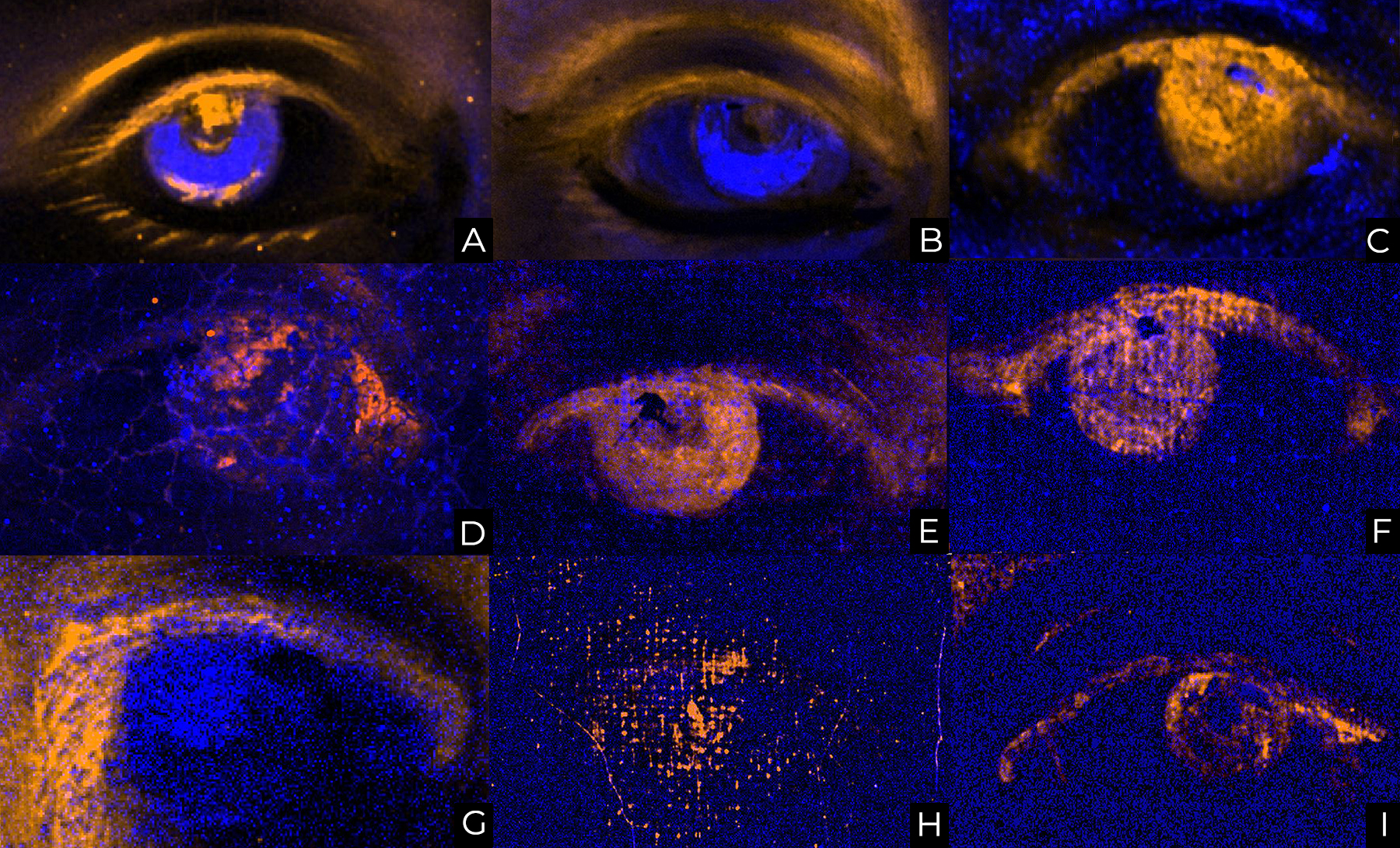 Fig. 1
Fig. 1Upon Lely’s death, the executors of his estate authorized former pupils and associates to complete the unfinished portraits that remained in Lely’s studio and to also restore a number of works in order to make them fit for sale.15 Thus, the very notion of a definitive date or an attribution to one artist was far from straightforward then and is therefore difficult to describe today. This paper does not delve deeply into authorship but, when possible, focuses on objects with solid attributions (through rare signatures, payments, or other records) as the starting point upon which to build a technical profile of that painter. That said, it is equally important to identify evidence of multiple hands at work, characteristic quirks, and generic practices, as they help differentiate the contributions of studio assistants from the primary painter.16
Cornelius Johnson (b. 1593 London – d. 1661 Utrecht)
Johnson was unusual among his contemporaries in routinely signing and dating his portraits. The five portraits in the YCBA’s collection that are inscribed span thirty years of a long career, from a somewhat stylized Jacobean period to the more gestural, swaggering Dutch subjects made after his move to the Netherlands in 1643.17 Today, there are only two firsthand accounts of Johnson’s painting practice: the first, a brief note by Théodore de Mayerne (1573–1655) on Johnson’s use of, and warnings about, orpiment; the second, recorded by Daniel King, on Johnson’s advice for painting drapery and, notably, his use of ultramarine blue as a final glaze.18
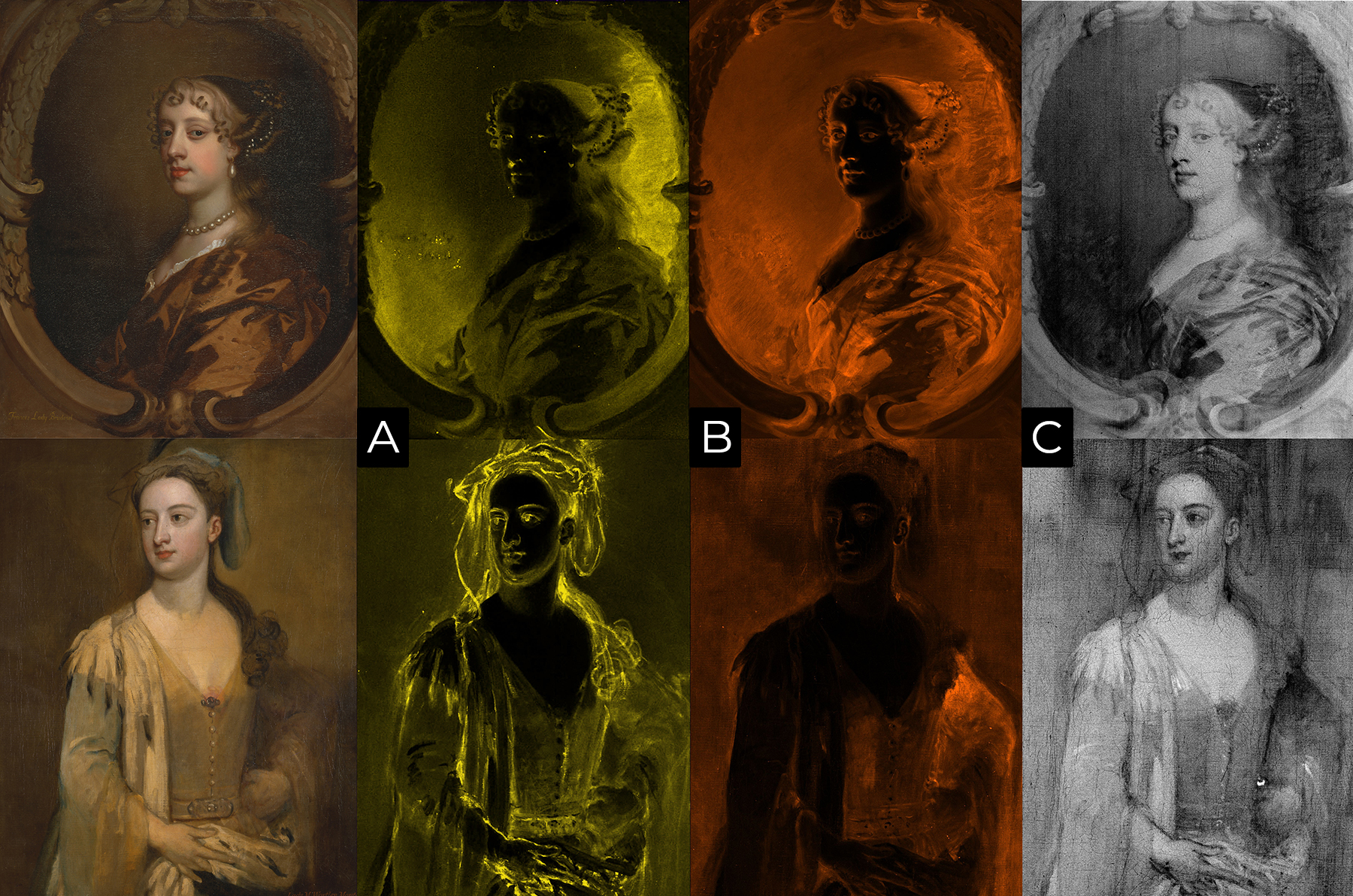 Fig. 2
Fig. 2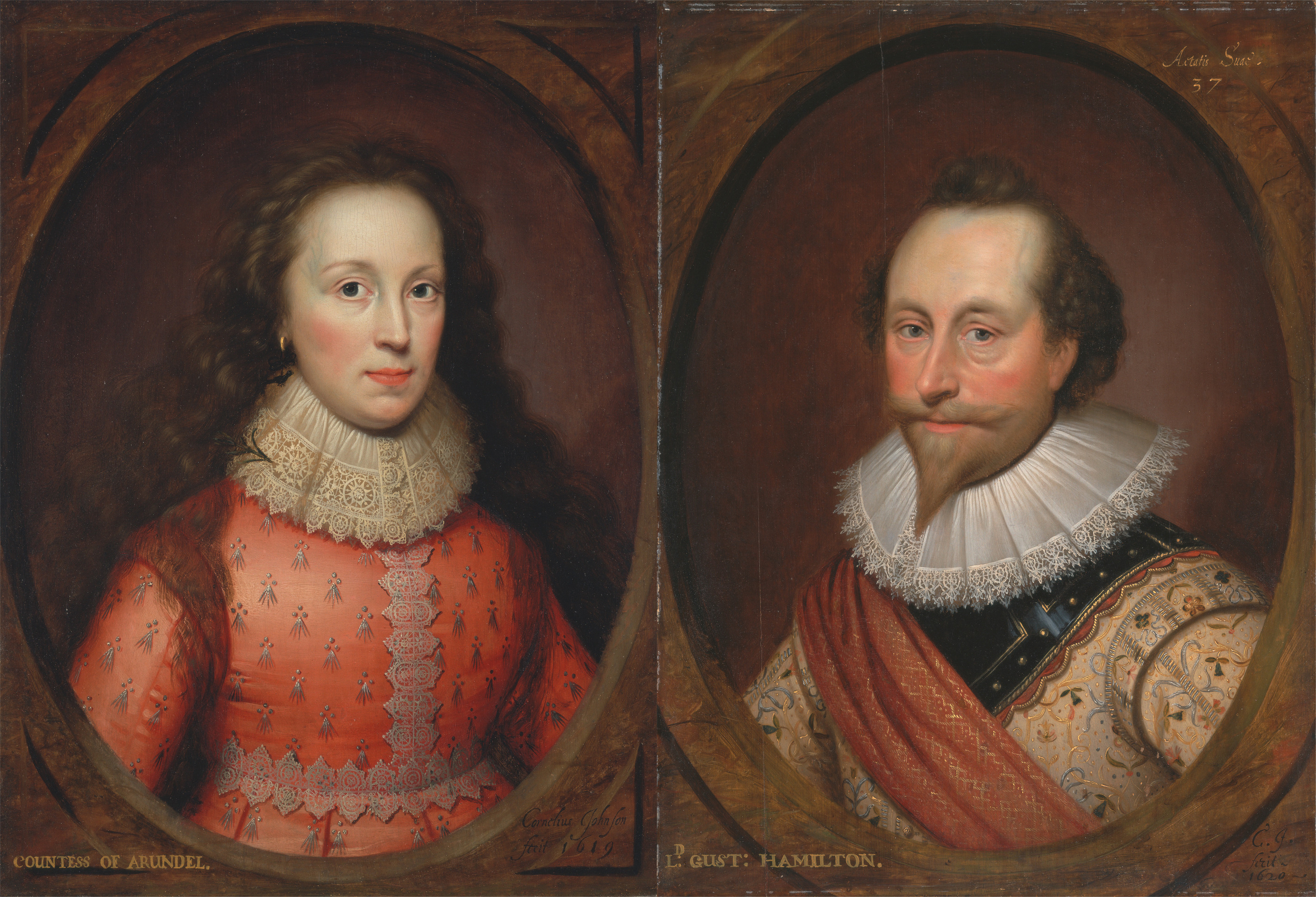 Fig. 3
Fig. 3Little is known of the size of Johnson’s studio at its height, but extant portraits such as that of Martha, Lady Penyston and her uncle Sir Alexander Temple (Fig. 3) help reconstruct the painter’s process and circle of patronage. It does not require spectroscopic analysis to see that Sir Alexander’s face is redder and rougher than Martha’s. In keeping with historical practices and contemporary texts on flesh painting, Johnson varied his palette according to gender, making the male complexion hotter than the female, and yet MA-XRF scans for iron and mercury show more than just an increased volume of certain pigments. Johnson pushed hue and texture to differentiate gender, lifestyle, and age. For example, the ruddy tones on Sir Alexander’s face were applied in discreet, almost hatched brushstrokes, whereas Martha’s soft blush was created with thorough blending, or “sweetening,” with a sable brush that thinned and smoothed the pink hue to a transparent veil of color (Fig. 4).19 Only on her eyebrows, eyelashes, and the azurite blue veins on her temple did Johnson permit the shape of the brush to leave a visible footprint.
The portraits once formed part of a set commissioned by Sir William Lenthall (1591–1662) at Bessels Leigh, Oxfordshire, completed by Johnson between 1619 and 1622. Johnson also made pictures for other members of this family, including the 1620 portrait of Susanna Temple, later Lady Lister (Tate Britain, London), where, again, Johnson emphasized the sitter’s youth and gender with a cooler flesh palette and careful wet-in-wet blending that visually “closed” the brushwork on her flesh without quenching the luminosity of the lighter paint below.20
The individuality of the sitters’ expressions and complexions, and the skillful juxtaposition of soft flesh, crisp lace, and patterned silks comprise a product that is technically sound, visually luminous, and shrewdly formulaic. It is unlikely that Johnson painted every part of these portraits himself. The sequential, wet-over-dry paint layering of the costumes and the fictive ovals created an opportunity for studio hands, as did the demand for additional versions. The portraits of Sir Alexander Temple and Martha, Lady Penyston (and quite possibly others not yet identified) were produced more than once (Fig. 5).21 Comparison of the two Lady Penyston’s shows how exactingly alike those versions were produced, suggesting they were completed in very close succession and possibly with both in the studio simultaneously.
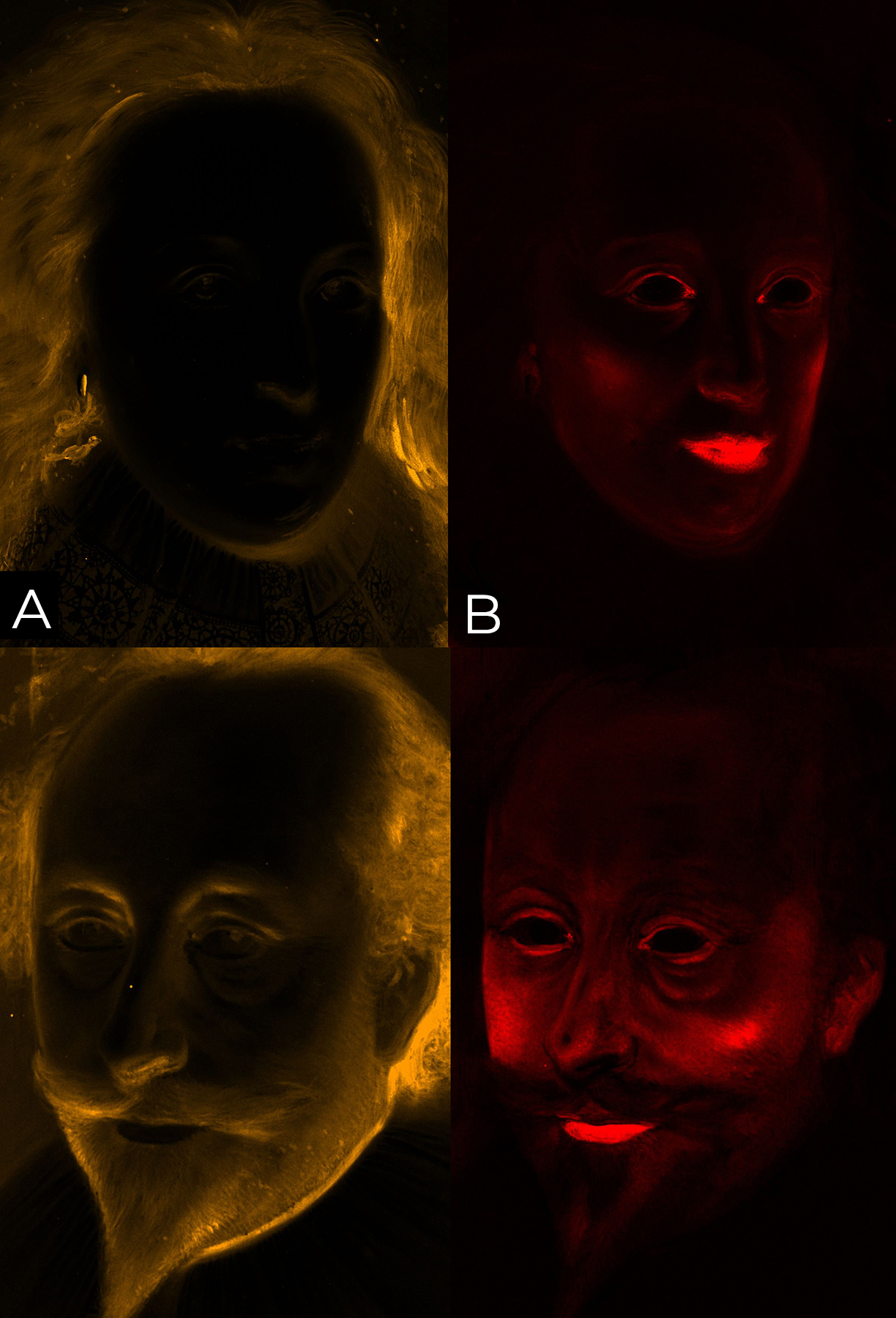 Fig. 4
Fig. 4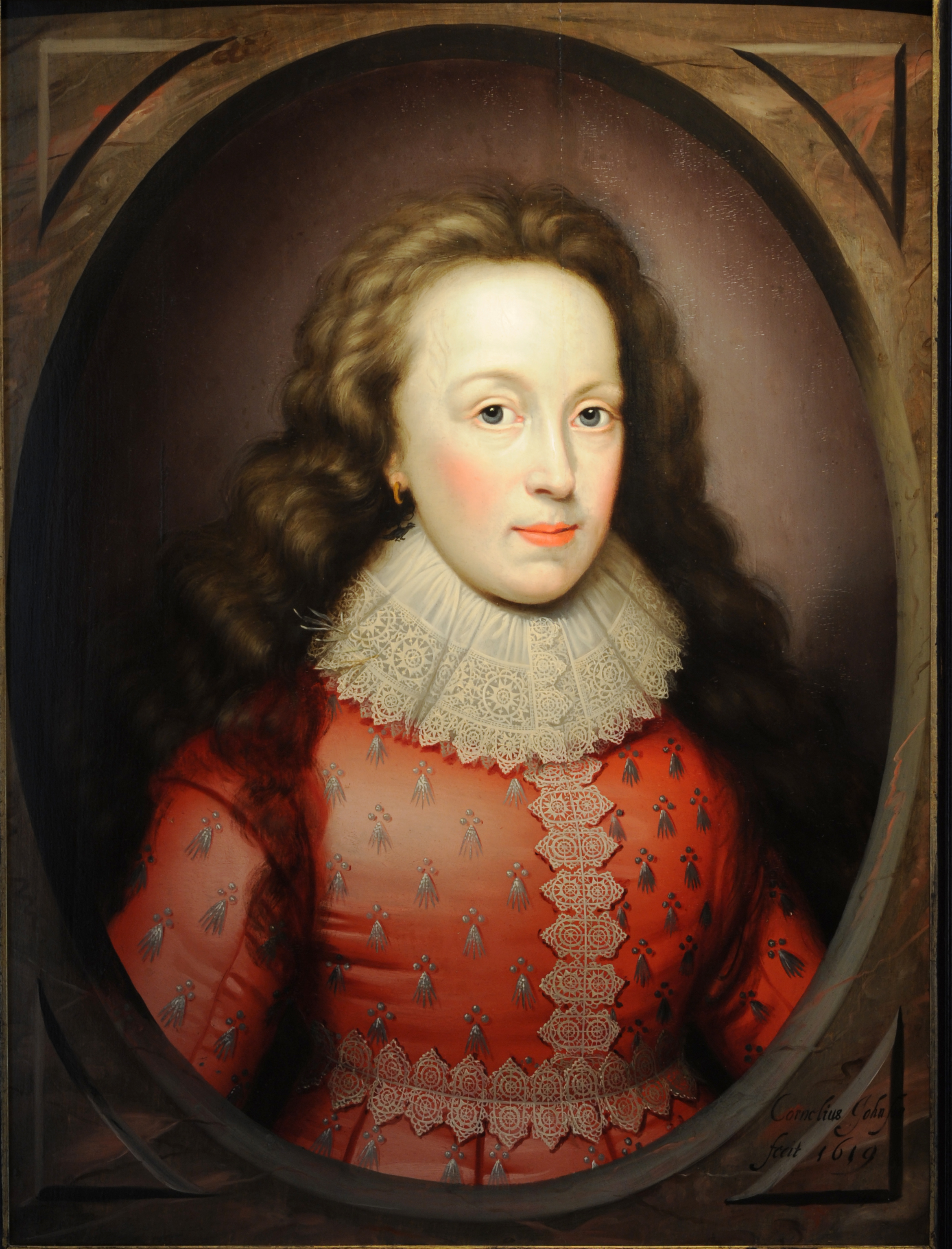 Fig. 5
Fig. 5Comparison of Johnson’s Sir Alexander Temple (Fig. 4) to the Portrait of a Man, a painting he made over thirty years later, illustrates an evolution in his technique (Fig. 6). The tidy brushstrokes and careful articulation of eyelids and lip shape evident in MA-XRF maps of Sir Alexander’s face were abandoned in favor of soft, gestural strokes, some sure, others almost searching, without an obvious formula. Both likenesses are individual yet bear the anatomical “stamp” of Johnson; the sitters’ crisply delineated irises impart a watchful, soulful expression, their foreheads high and luminous but the crown of their heads slightly squashed, and their low shoulders sloped to make a wide pyramidal shape of their busts.22 But the articulation of every detail—metallic embroidery, spangles, loose hair tendrils—seen in earlier portraits gave way to a softer, atmospheric quality in the later paintings, where only a few, subtle clues were provided about texture: the hazy bluish highlights on black velvet and the flash of a sparkly ring in the shadow.
The presence of specific pigments in the above paintings that can be inferred from MA-XRF analysis (lead white, ochers, earths, brown umber, azurite, and bone black) comprise a small portion of the palette outlined in contemporary manuals and manuscripts, which include the following: lead white, ochers (yellow, brown, and red), massicot, orpiment, yellow lake or “pinke,” vermilion, red lead, various organic red lakes (cochineal, brasil wood, and carmine), Indian red, azurite or bice, smalt, indigo, ultramarine, ultramarine ashes, verdigris, green verditer, spa green terre verte, umber, asphaltum, Cologne earth, Spanish brown, burnt ivory, lamp black, charcoal, sea coal, and lamp black.23 The limitations of XRF analysis result in significant omissions from the flesh palette, namely organic materials like red lakes and “pinkes” (meaning organic yellow lakes). However, XRF can provide clues to the locations of organic lakes based on identification of inorganic “ingredients” used in their production (i.e., aluminum hydroxide, potassium carbonate, and calcium sulphate).24 The deep berry hue on Martha’s lips and nostrils, for example, corresponds to a density of calcium and potassium, which, when compared to the painting, neatly follows brushstrokes of red lake–like paint (Fig. 7).
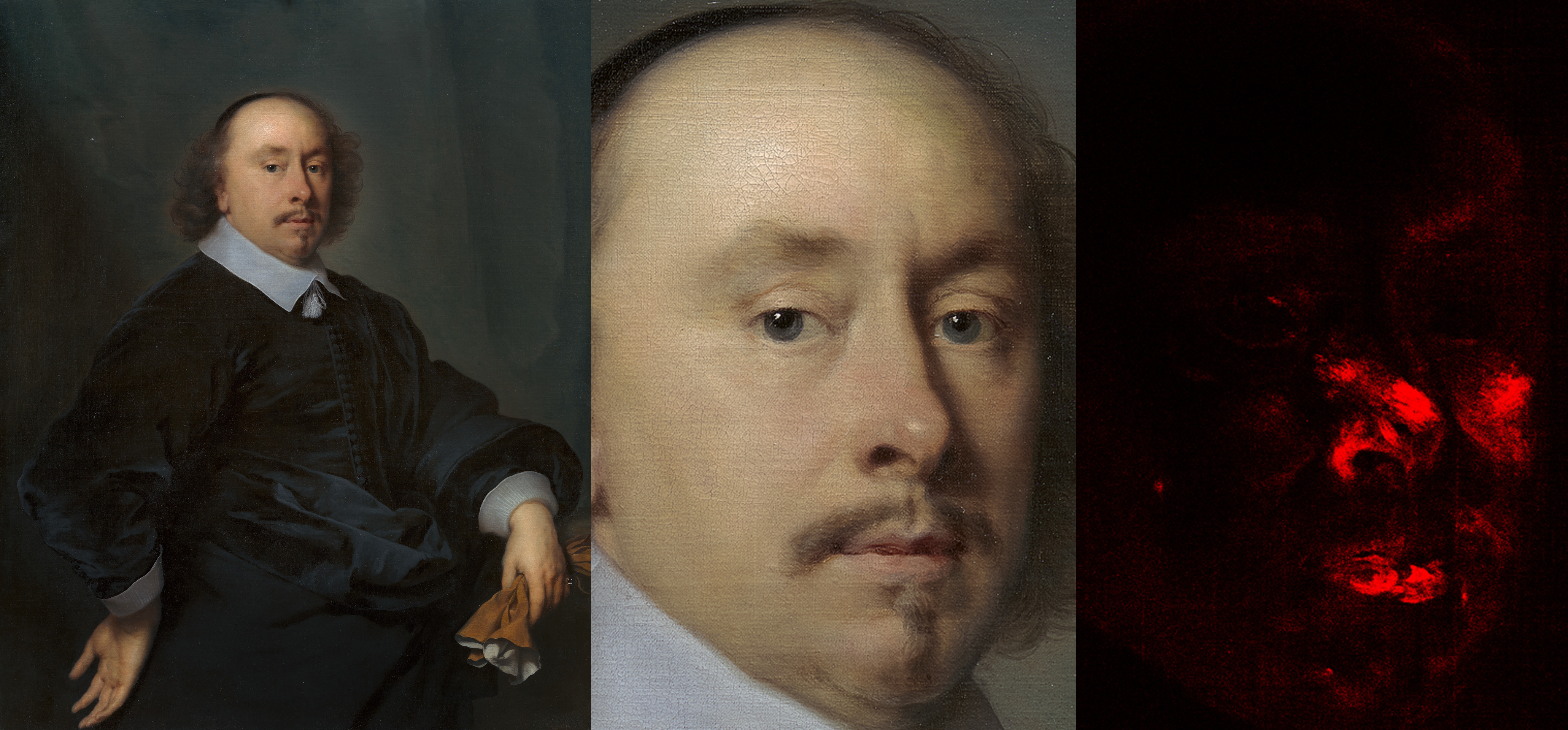 Fig. 6
Fig. 6 Fig. 7
Fig. 7
Sir Anthony van Dyck (b. 1599 Antwerp – d. 1641 London)
The shift in Johnson’s style and his method of paint application can be seen as indicative of shifting tastes in portraiture and in particular the influence of Anthony van Dyck, which is apparent in Johnson’s work from the 1630s.25 The range of pigments available to painters changed little over this period, but the various ways that they were used was of great interest to contemporaries, particularly as related to Van Dyck. King, for example, described Van Dyck’s three mixtures for “carnation tints” (warm/ rosy hues) and “bluish scumbles” for cool tones.26 The pigments are not always named specifically; for instance, King described the carnations as varying mixtures of white, burnt ocher, red ocher, plus unspecified “red” and “yellow” pigment. Composition of half-shadow tints applied “between the deep shadow and flesh colour” are specifically named as “sea cole” black, white, and ocher, which “he scumbles over with bise white red xc.”27
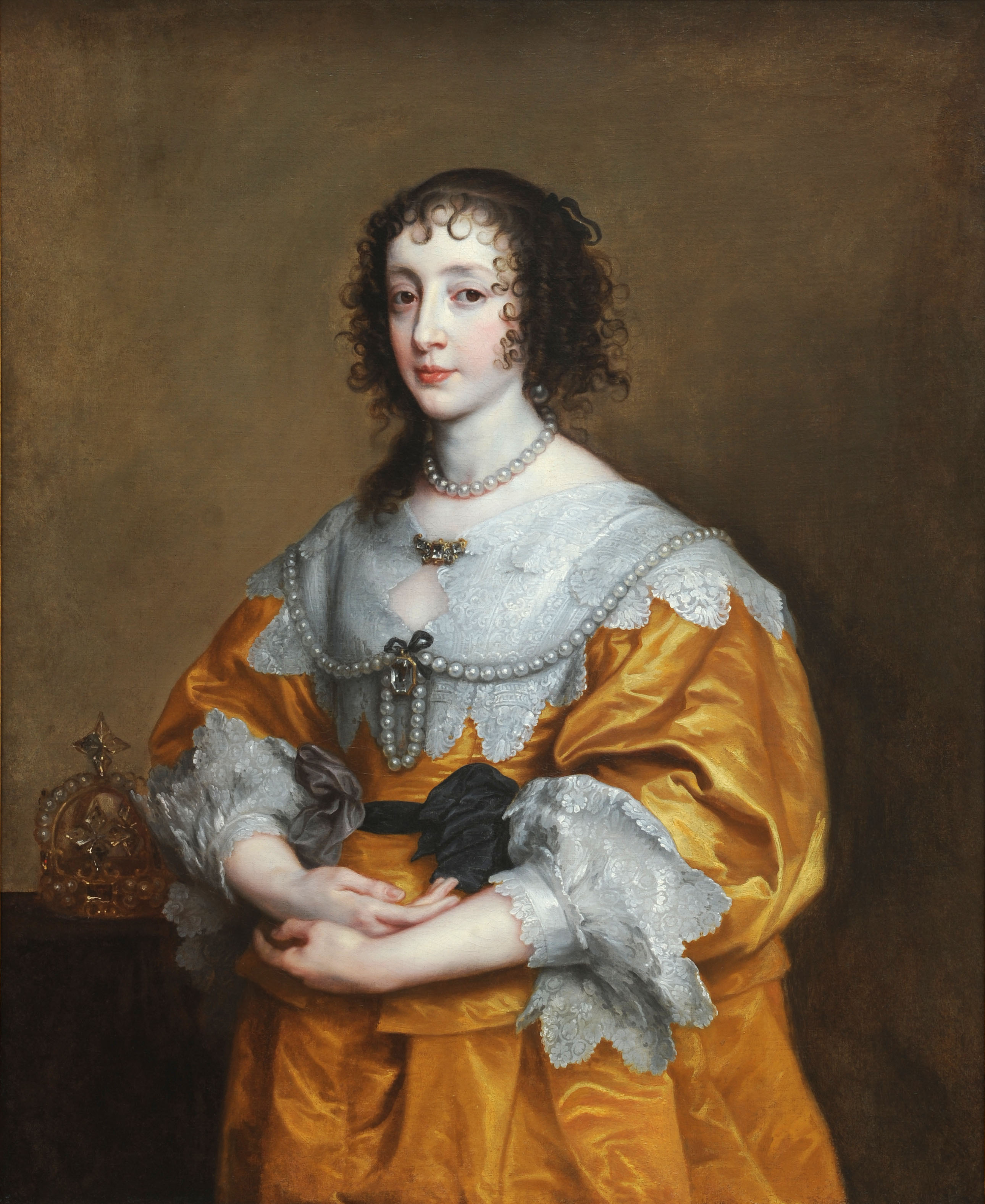 Fig. 8
Fig. 8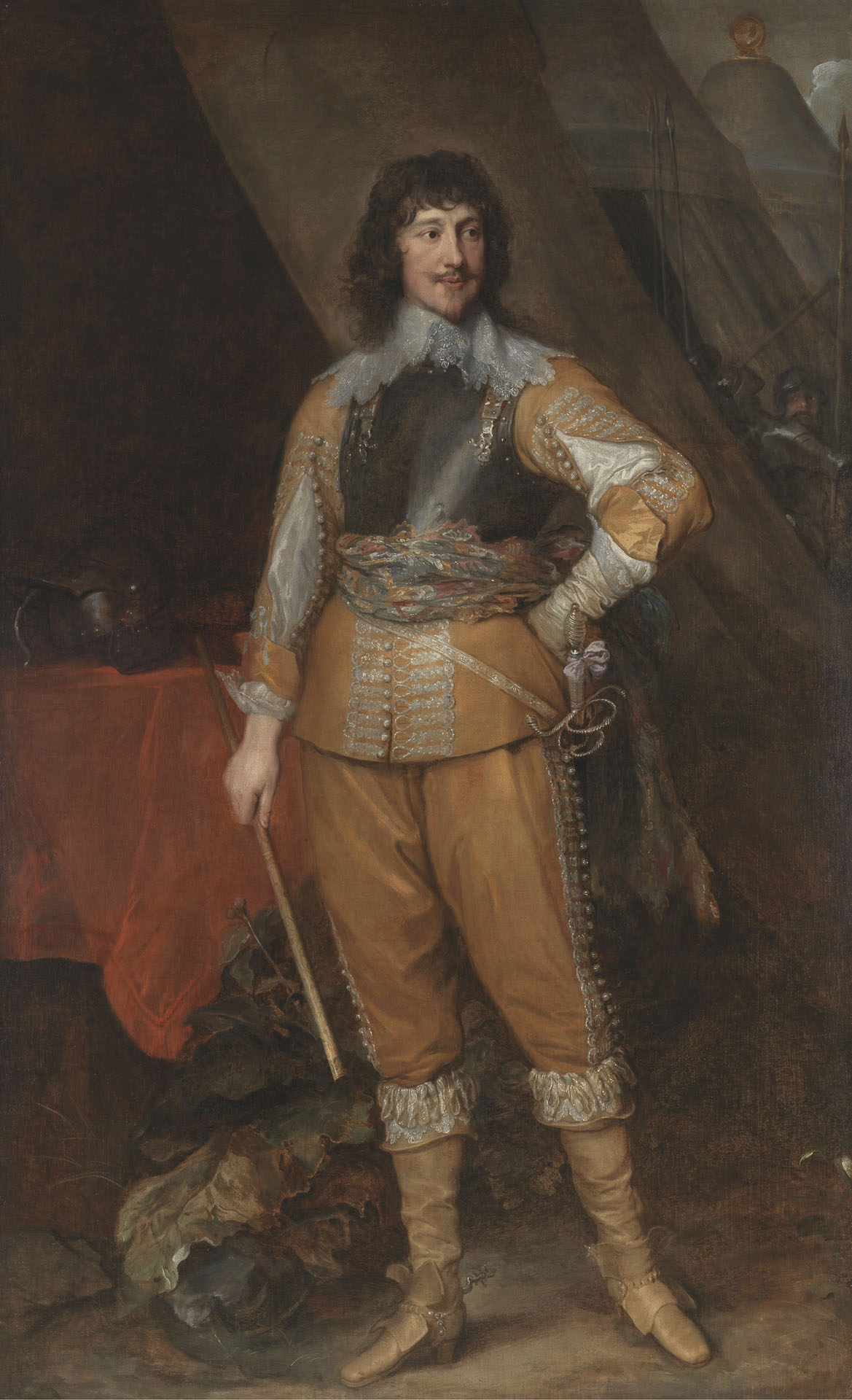 Fig. 9
Fig. 9The portrait of Queen Henrietta Maria, one of many high-quality versions of this likeness, and that of Mountjoy Blount, Earl of Newport support King’s account to an extent (Figs. 8, 9). Visual examination, supported by MA-XRF analysis, reveals soft gradations of iron-based earths mixed with lead white blended across their flesh and then, mixed with umber, daubed to reinforce shadows. In neither portrait does vermilion pigment seem to be mixed into those modeling layers, but rather was added later in the painting process—sparingly to Henrietta Maria’s cheeks, tear ducts, and lips, and enthusiastically to Mountjoy’s visage (Fig. 10). The flesh paint is thin and permits the peach-color imprimatura to peek out along the sitter’s eyelids, cheekbones, and the bridge of the nose. The underlying brown umber “sketch” that delineates the features along the shadowed sides of the face (the left side on Henrietta Maria; the right on Mountjoy) was also left partially visible.
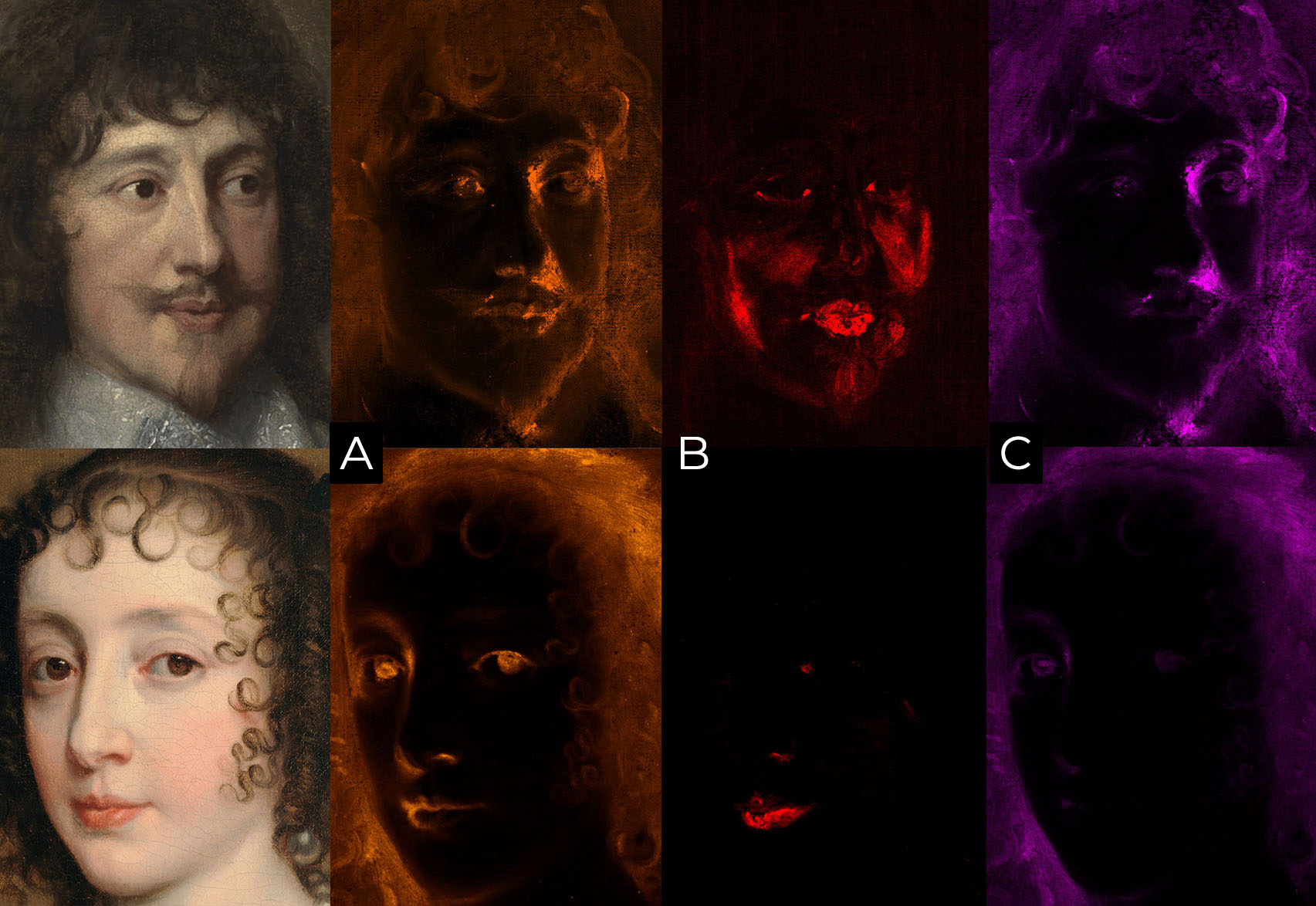 Fig. 10
Fig. 10The flesh paint on Henrietta Maria is in better condition than on Mountjoy Blount, and it is, therefore, clearer to see that the transitions between the deep shadows and flesh tones on her face were “bridged” by a greenish blue paint, a mixture of lead white, black, and ocher particles followed by scumbles of high-grade azurite (Fig. 11). MA-XRF affirms that most shadows on her face contain azurite; sometimes applied in dense daubs, such as under her eyes and on her neck, and in other places as a thin bluish tint that skims over highlights to impart a luminous glow. Some azurite was detected on Mountjoy’s face and hand, but rather than crisp strokes and scumbles over flesh mid-tones, it seems to be concentrated in areas of shadow and therefore likely relates to a drying accelerant like a copper-infused oil or sparse amounts of verdigris rather than blue pigment (Fig. 12).28
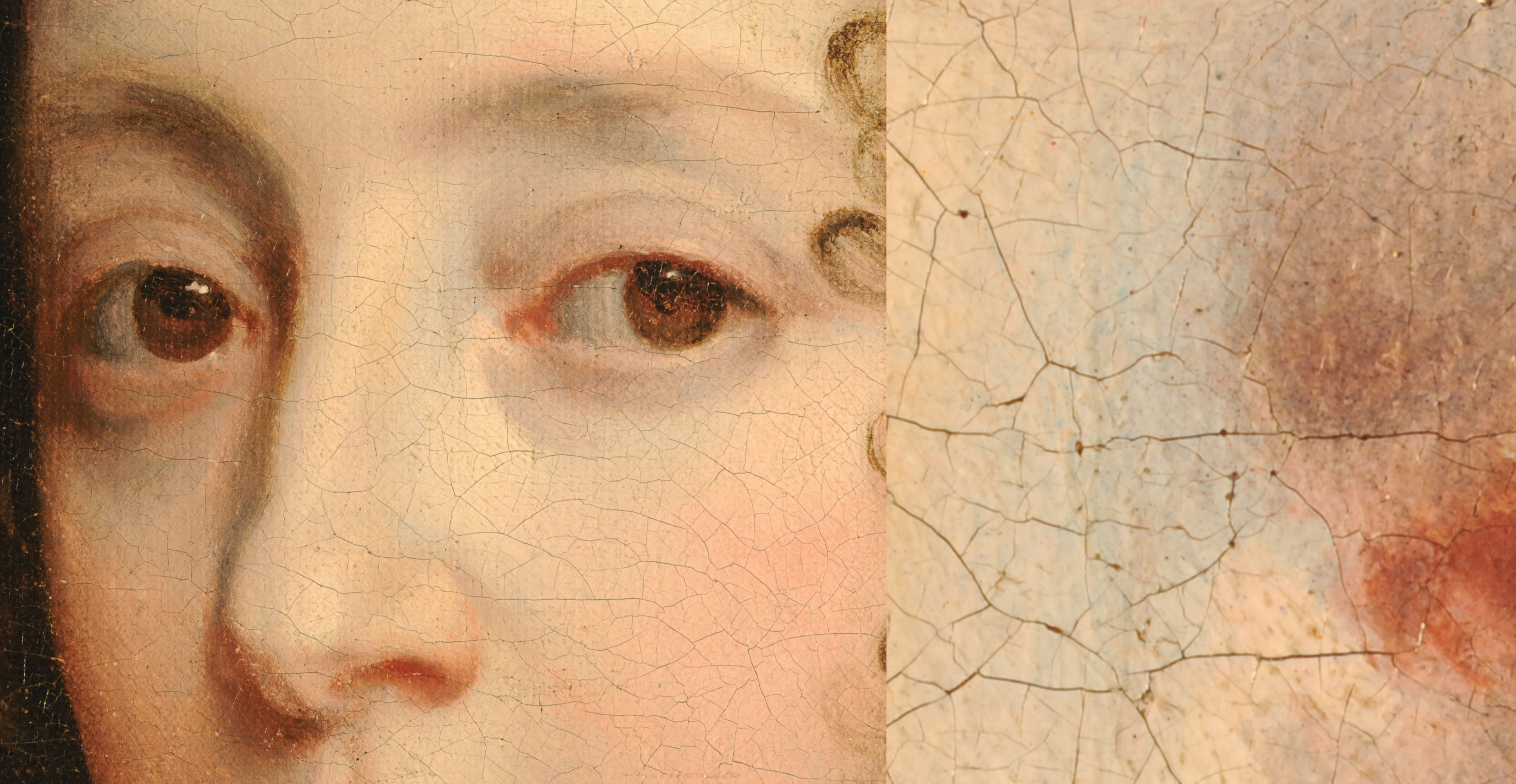 Fig. 11
Fig. 11The “Gandy Diary,” an anonymous journal attributed to the minor portraitist William Gandy (d. 1729) is a compilation of firsthand accounts, technical critiques, and gossip pertaining to the paintings and practices of portraitists such as Van Dyck, Lely, and Kneller.29 Between 1691 and 1692, the author visited several Van Dycks and made visual analysis of their palettes and layer structures. Like King, Gandy also noted the painter’s use of blue scumbles, writing, “I observed that the flesh was broken with blue where the light was, & all over as in this Nature he took a middling Hoggtoole [hog’s-hair brush] or a large [brush] or according as the place did require and & laid it all on, broad, with some flesh broken with blue, then . . . breaking it with more blue.”30 In short, Gandy (similar to King) recognized Van Dyck’s generous use of blue scumbles on his sitters’ faces to bridge highlights and mid-tones and to delineate cool shadows.
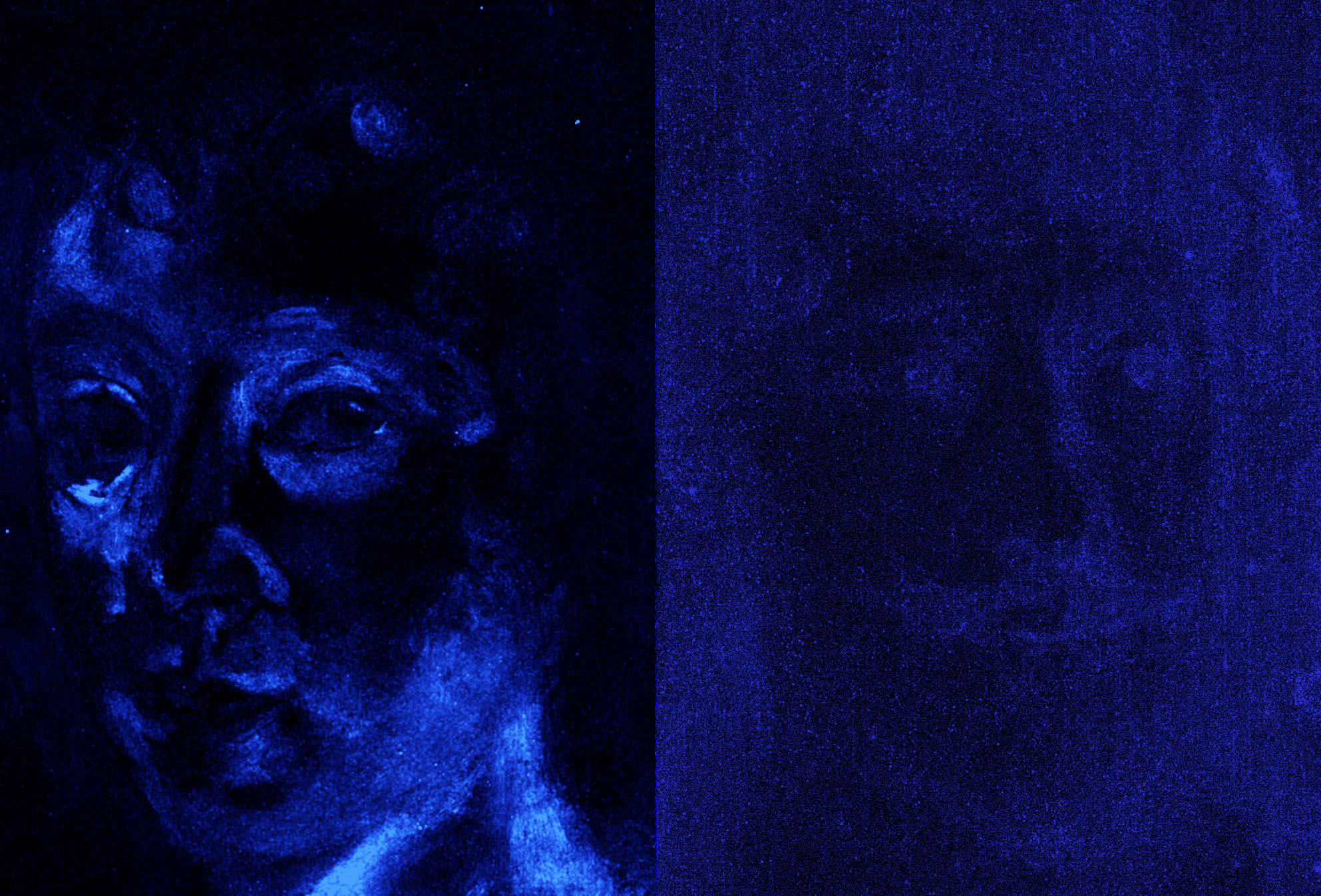 Fig. 12
Fig. 12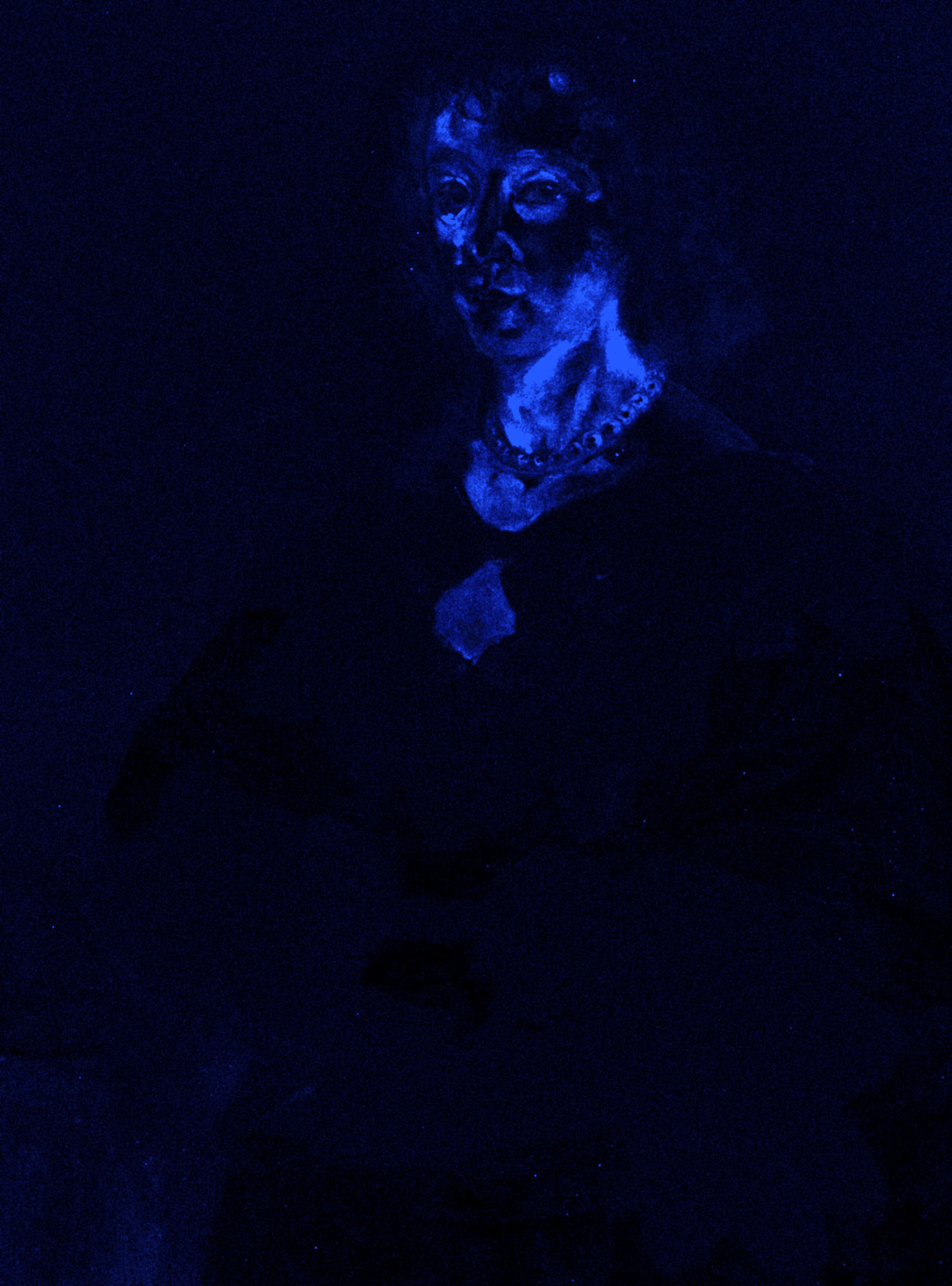 Fig. 13
Fig. 13At another point, Gandy saw Van Dyck’s portrait of the three eldest children of Charles I and Henrietta Maria, and commented, “Vandike about his hands used yellow ochre & red ocre only.”31 Perhaps not coincidentally, Gandy’s observation corresponds to the portraits discussed here. MA-XRF analysis combined with microscopic examination of the paint layer shows that the quantities of azurite used to almost sculpt the flesh tones of Henrietta Maria’s face and bust were substituted on her hands with a modest mixture of lead white, earth pigments, and a little black (Fig. 13). And, neither sitter’s hands contain considerable amounts of vermilion. On neither portrait is a discrepancy between the flesh passages evident by simply looking, and it is curious that Gandy had the confidence to make these judgments on Van Dyck’s pigment mixtures, unless of course he was party to a firsthand account of the artist’s technique—in other words, if a member of Van Dyck’s studio informed him that costly pigments were limited to specific commissions and/or to privileged passages of the canvas, such as the face and textiles of the primary figure. The difference in paint mixtures may also be purely practical, illustrating that the hands were painted at a different stage than the sitters’ faces, likely by assistants using generic flesh-paint mixtures that were never intended to precisely match or compete with the sitters’ visages.
Sir Peter Lely (b. 1618 Soest – d. 1680 London)
Some of Gandy’s notes on specific painters take the form of conversations with his “informants.” For example, he says “to Mr. [William] Fever that Vandike, did not paint with so much variety of Colouring as Lilly did.” To this Fever replies, “Vandike had as great variety of Colouring as any other, but Vandike did obscure his Colouring with—Sweeting over the surfaces, . . . he obscured his Art.”32 This is not a critique commonly associated with Van Dyck today, but Gandy and Fever, who at that moment seem to be high-level (studio?) assistants, regularly engaged in the comparison and critique of painters from the previous generation. Their comments indicate a shift in taste away from the soft-edged, atmospheric haze created with wet-in-wet layering and soft blending toward a more direct, painterly approach. Lely, Gilbert Soest (ca. 1605–81), and Kneller advocated (through explicit advice or practice) extensive pre-blending of hues on the palette and limited blending on the canvas.33 Lely advised Fever to “lay your patches of Colouring one by another & not Colour upon Colour, and only hack them together & keep them beautiful and Clear.”34
Anecdote paints Lely as secretive. His long-time apprentice John Greenhill reported that he never saw his master paint a face from life, which, given the evidence of Greenhill’s aptitude as a portraitist, may be something of an exaggeration.35 Lely was certainly observed in the act of painting by Gandy’s mysterious William Fever, as well as Mary and Charles Beale, although the Beales did have to pay for the portraits and by extension the privilege of watching the master at work.36 The tremendous demand for his portraits, as well as copies and versions, compelled Lely to “commercialize.”37 His studio was filled with unfinished canvases of what he called “poses”; pre-prepared canvases left half finished (no doubt by assistants) from the bust down, onto which sitters could have their heads placed by Lely.38
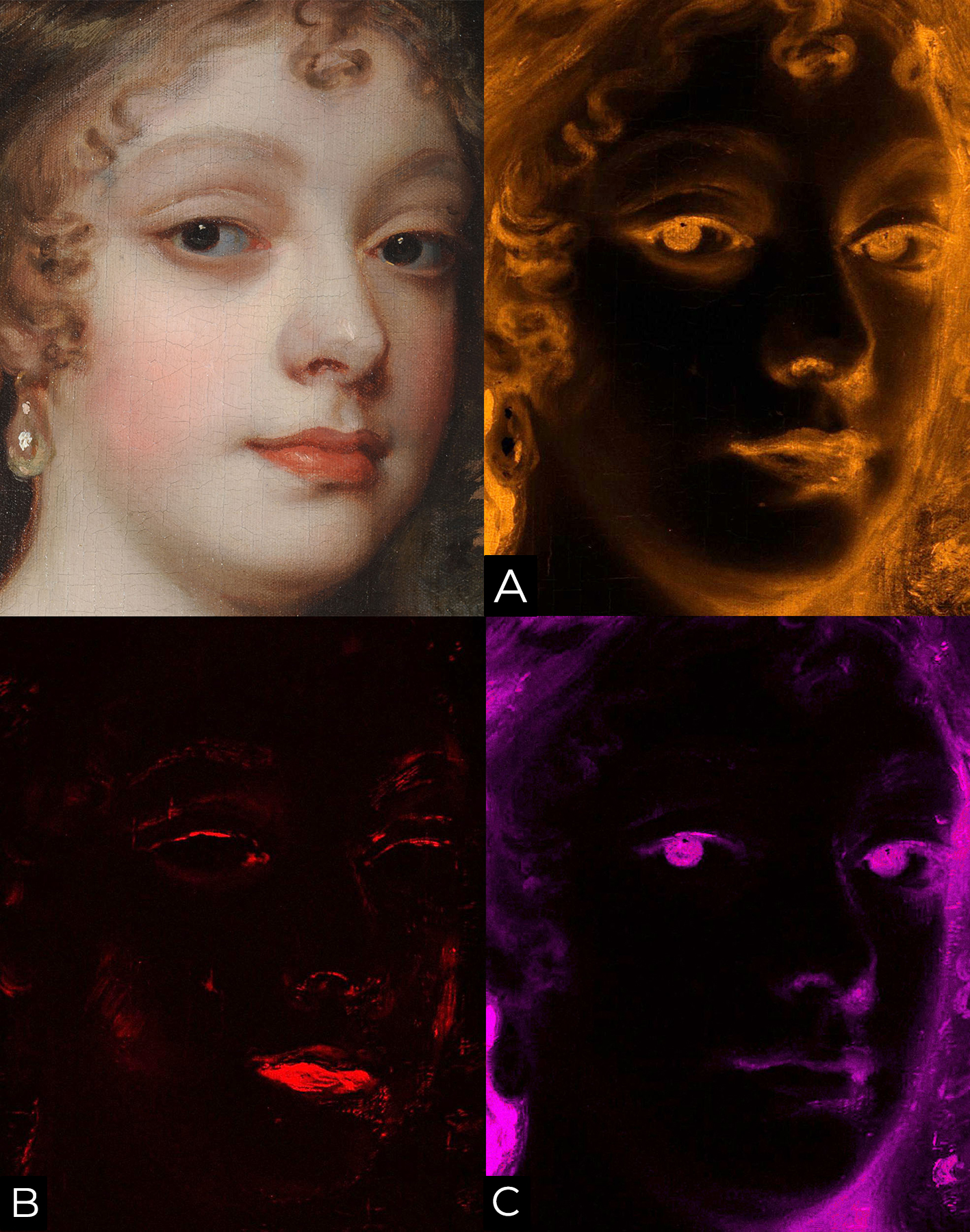 Fig. 14
Fig. 14According to Gandy’s source, Lely started every likeness with many gradations of just lead white and earths, similar to Van Dyck. These were laid and adjusted over numerous sessions on top of a flat dead color, “a mediam that he might put in lights & darkness in the finishing, so that the dead color stands for something,” meaning the dead color played a role in the finished painting.39 It is impossible to dissect the number of sittings over which Diana Kirke’s head was painted, but microscopic examination of the paint’s surface helps inform a basic stratigraphy. Comparison of the paint layer with MA-XRF maps for iron, manganese, and mercury illuminate specific pigment mixtures used, including many discreet strokes of pure earth pigment, followed by brown umber to reinforce features, and then vermilion for Diana’s blush and the hot shadows on her mouth, nose, and eyes (Fig. 14). In many places the paint “patches,” or the footprint of the paintbrush, is un-smudged, suggesting that each application was allowed to dry before the next went down, both to build up deep shadows and retain a range of local hues that layering and soft blending could obliterate. The result is a patchwork of subtle hue shifts, which is even more evident on the faces of Lely’s male sitters, such as Sir Ralph Bankes (Fig. 15).40
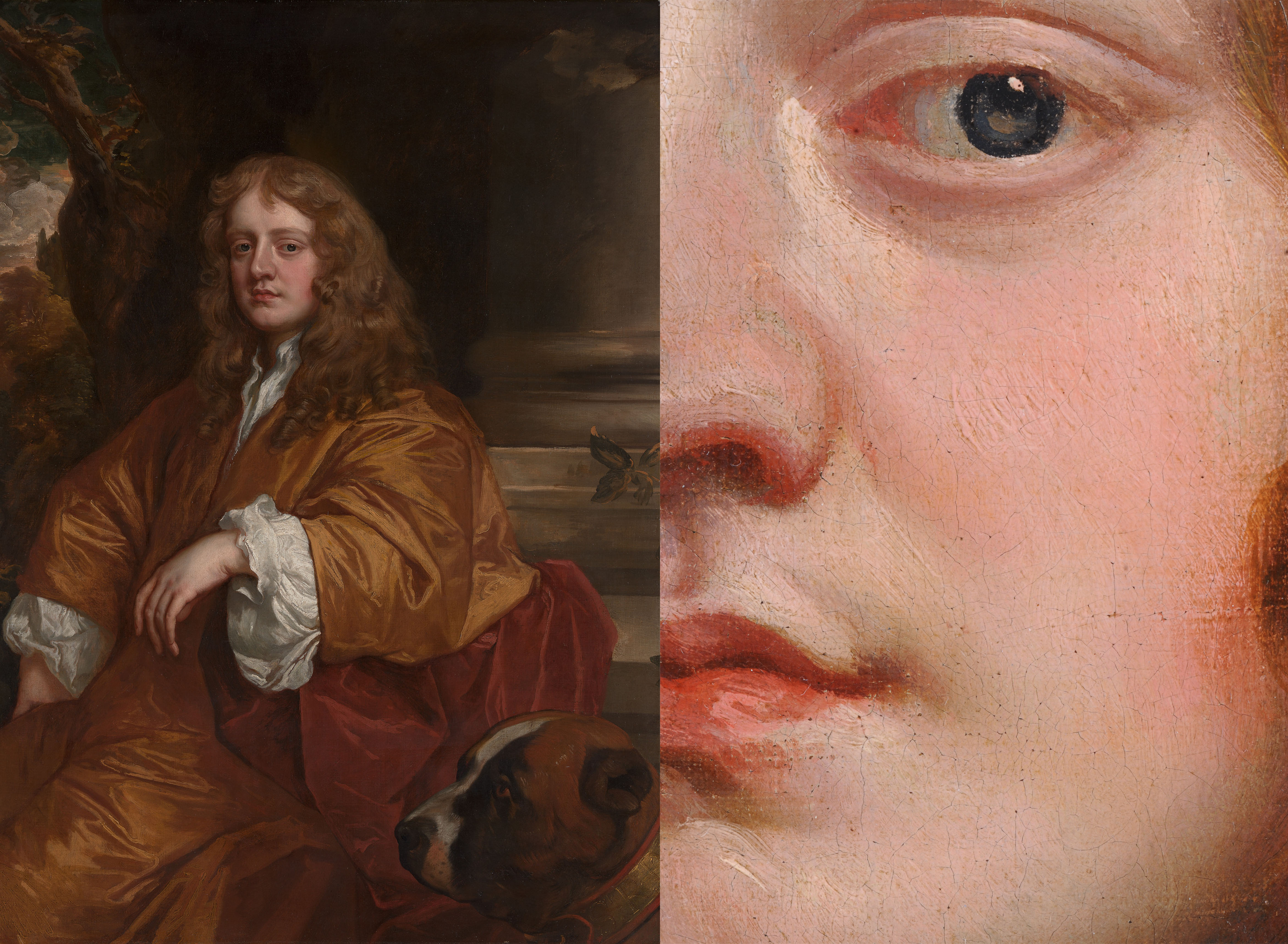 Fig. 15
Fig. 15Many years after it was painted, Gandy copied a portrait of Isabella Dormer, observing that “it did Shine like a thousand Glowormes” and in places the brushwork was “very rude & Edgey.” These were compliments, for as he goes on to say, “if you sweeten [the paint] together you take away the Spirit & it is quite spoiled.”41 The words “rude” and “edgy” in this context seem to mean rough or unresolved, but deliberate. This idea of belabored nonchalance was clearly on Gandy’s mind, as in the same year he made the copy of Dormer, he recorded a comment from Fever that “[Lely] put in the touches & dashed over here & there, with Judgement, this made it seems careless or done with a Sight, but the great labour & pains was done before.”42
Mary Beale (b. 1633 Barrow – d. 1699 London)
Mary Beale is recognized as the most commercially successful woman artist of the seventeenth century. Her husband, Charles, worked for the Patent Office and was also a colorman who made and supplied painters’ materials, including a special red lake used by Mary and several prominent painters in their circle.43 Charles kept notebooks from at least 1660–81 documenting his trade, family accounts, and details of his wife’s studio activity.44 Mary Beale was clearly on good terms with Lely. They dined together, Lely gave her advice, and he lent her paintings from his personal collection, works by Van Dyck and various Italian masters, which she only returned upon his death. Attributions to Beale can be difficult because of her great talent for making copies and emulating Lely’s style specifically.45
Beale was interested in fast painting—the single sitting—and talked with Lely on this subject. On one visit to her home, Lely took notice of a Van Dyck there. Clearly an object of significance to her, she posited how Van Dyck, “could possibly divise to finish in one day a face that was so exceeding full of work and wrought up to so extraordinary a perfection.”46 Lely replied that it looked to have been “painted over” fourteen times. He then recounted an anecdote told to him by the painter and musician Nicolas Lanier, who claimed that when he sat for Van Dyck it took the master seven days to capture his face and he was still not satisfied with it. Lely, it should be remembered, was not himself a fast painter, although he endeavored to hide the laborious stages of painting.47
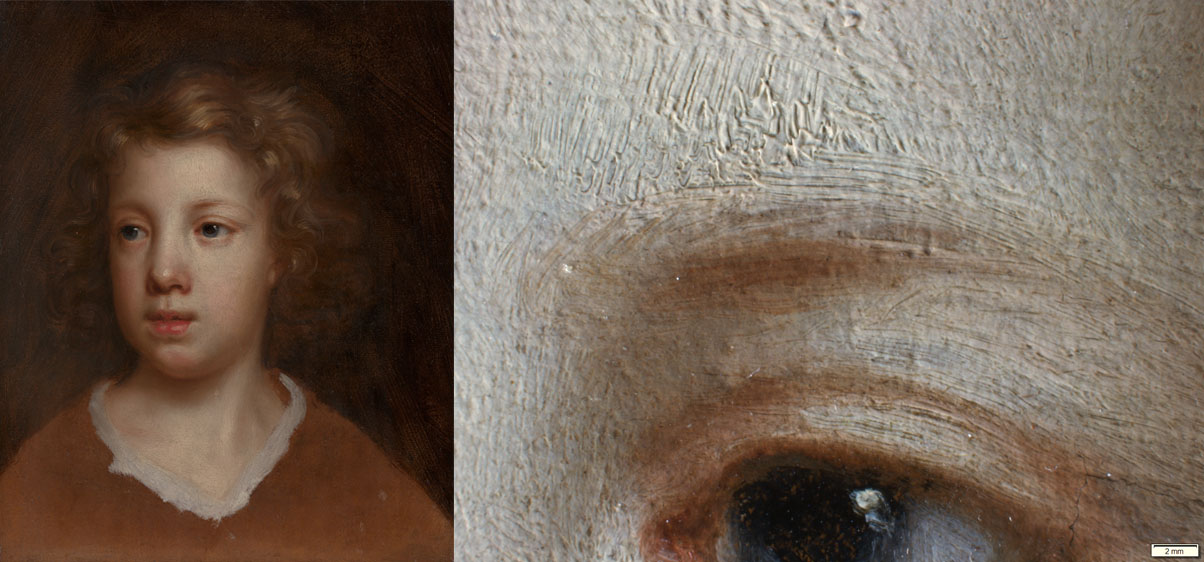 Fig. 16
Fig. 16Beale’s portrait of Bartholomew is one of many depicting her sons, most left unfinished from the neck down (Fig. 16). The technique is so brusque, the brush digging and smearing the paint, that it almost looks as if it could have been completed in one sitting.48 In fact, Mary mastered what Gandy envied of Lely, the appearance of very fast painting, accomplished here in about three steps. The basic placement of Bartholomew’s features was sketched with a dark brown umber, which was also spread across the background (and is still visible there).49 Beale then worked up Bartholomew’s flesh very swiftly, perhaps in one go, with a mixture of earths and lead white. These hues are evident under magnification, but MA-XRF provides a clearer image of the paint’s application by showing the distribution of pigment particles within each brushstroke, beginning with a mixture of lead white and earth pigment, slightly gradated, dragged straight down the left side of the cheek (Fig. 17). Next, a scattering of vermilion pigment was laid on top. This application does not smear the underlying stroke, indicating that it was already dry. Beale then cleaned up Bart’s silhouette by adding more umber around his head.50 The pigment mixtures and sequence of paint application are not vastly different from those on Lely’s Diana Kirke or Lady Frances Savile, but the result shows genuine immediacy rather than affected facility.
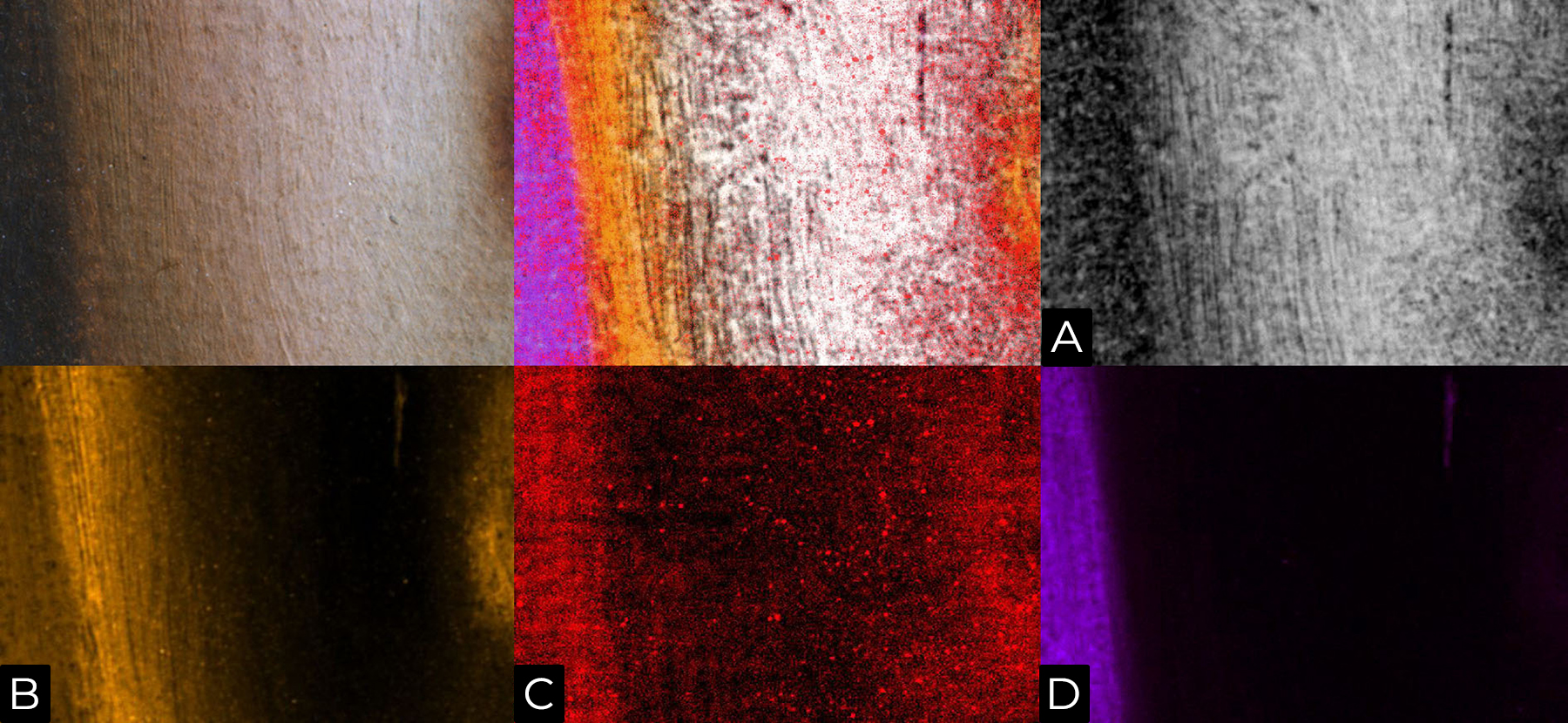 Fig. 17
Fig. 17Sir Godfrey Kneller (b. 1646 Lübeck – d. 1723 London)
Unlike Lely, Kneller let anyone watch him paint. He reportedly worked on multiple likenesses in a single day, always in his studio, the faces painted from life in sittings as short as one hour. In 1693 he described to Gandy how to paint a face in under an hour, which explains why the paint-off with Lely turned out in his favor. His work was noted for its unfinished or sketchy look; the costumes and backgrounds left unresolved, and this became a vogue among contemporaries who sought to emulate his effortless fluidity. But even those who observed him in action were little enlightened, as his process was so swift and intuitive that his methodology remained beyond them. Miniature portraitist and author Jean André Roquet observed that “Kneller was in every respect a difficult pattern to follow and yet all the English painters would fain imitate him. . . Several were so affected, as not to cover the whole canvas.”51
Kneller rarely traveled to take a likeness and clearly preferred to work in his studio where light, sitting distances, and the arrangement of mirrors—for the benefit of sitters and onlookers—could be controlled.52 Alexander Pope urged him to make one exception for his friend and patroness, Lady Mary Wortley (see Fig. 2). Pope explained to Lady Mary that Kneller “thinks it absolutely necessary to draw the Face first, which he says can never be set right on the figure if the Drapery & Posture be finished before.” Having apparently negotiated the arrangement with Kneller, he further explained that “he proposes to draw your face with Crayons, finish it up, at your own house, in a morning; from whence he will transfer it to the Canvas.”53
It seems almost certain the YCBA’s portrait of Lady Mary Wortley is a product of that commission. The portrait is typical of Kneller’s loose, searching method of paint application; stray contour lines buzz around her silhouette and the mark of the brush is visible throughout, flicked to draw a linear shadow on fabric, dragged to make a bluish scumble on flesh, and daubed for impasto highlights off the tip of a hog’s-hair brush. The paint of the flesh is thicker than any other passage and although there is some soft, wet-in-wet blending (of cool highlights into her rosy cheeks, for example), the premixed paint “patches” were not merged. As a result, the thicker flesh tones seem to hang on the armature of her features, with the ground color peeking out along most facial contours. Her textiles and hands were described with lean, fluid paint that sketches their proportions without defining their shape or articulating texture.54
This concentration of thick, mostly unblended paint on Lady Mary’s face, as well as several other Knellers at the YCBA, resonates with advice he gave to Gandy when he had to capture a likeness quickly, emphasizing, “Mind only to get the likeness . . . when you have got the likeness & it is Scumbled all over, then Imboss your face and fill it with Colour, This Method makes nothing of Painting.”55 Gandy observed Kneller working and noted that after applying premixed tints to his sitters’ faces with a bristle bush, he “heaps it with Colours in the middle of the face so leaves it When he finish the 2^nd^ or 3^rd^ Setting . . . he only minds the likeness put in the Spirit, to get in the likeness takes up all his Time.”56 The lack of punctuation clouds Gandy’s meaning, but the emphasis in both accounts on capturing and preserving likeness stands out. The likeness, it seems, was captured early in the process and guarded as painting progressed, presumably so the portrait would not lose its resemblance to the sitter, especially if they only sat for Kneller once as in the case of Lady Mary.
Like Johnson, Kneller varied both his palette and his brushwork according to the sitter’s gender and age. Compared to his Lady Mary, the flesh paint on Sir Theodore Colladon of ca. 1705 and Henry Portman Seymour of c. 1714 (both at the YCBA) resembles islands of unblended, subtle hues laid down with directional brushstrokes that help model the topographies of those male faces (Fig. 18). But in all the portraits examined, Kneller’s paint never completely covers the contours of his sitters’ features; male or female, the light (sometimes greenish) gray underlayer remains visible, like guidelines along their features.57
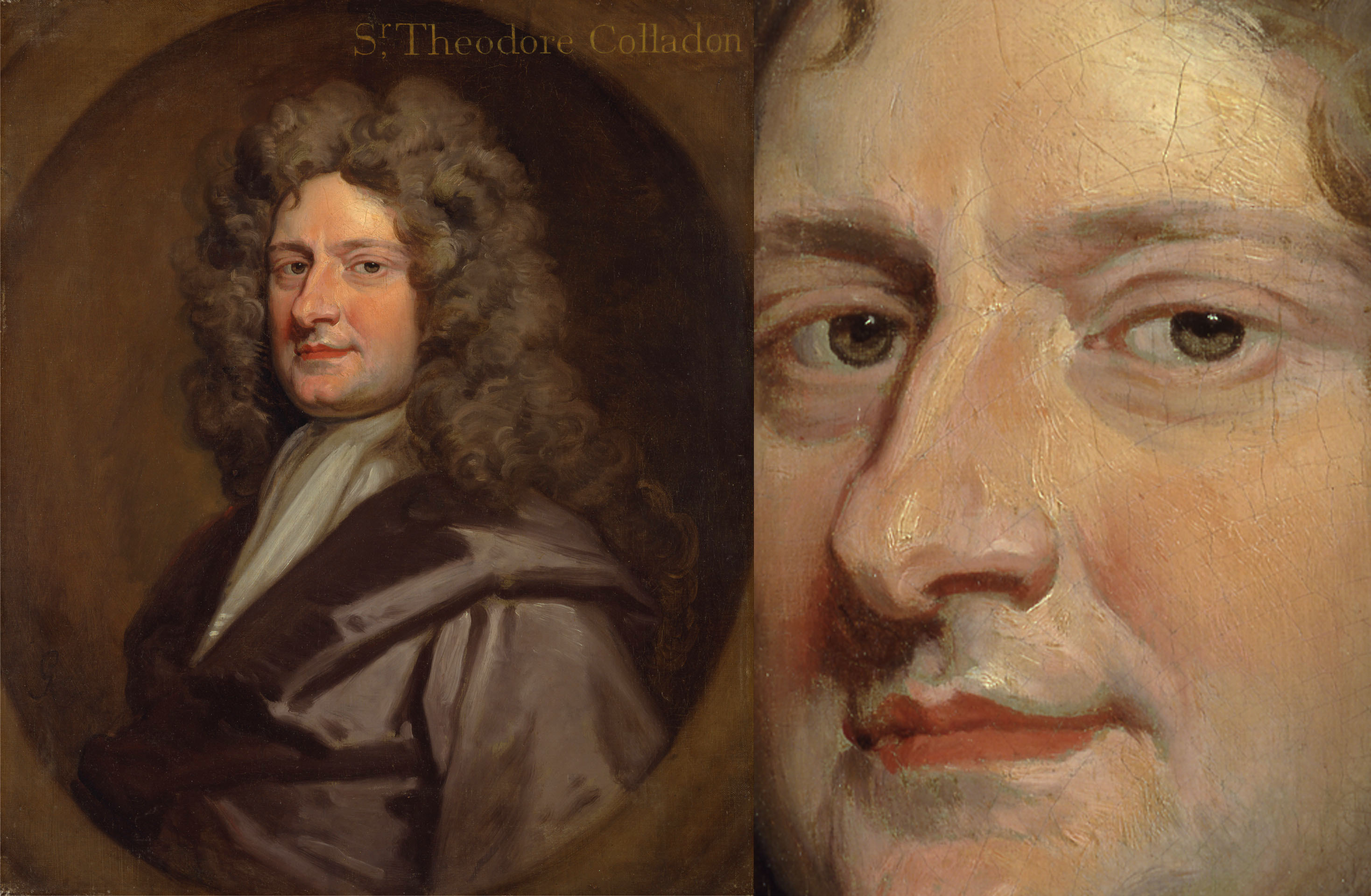 Fig. 18
Fig. 18The “footprints” or gaps in the upper paint layers that allow one to see down to the ground color tend to be narrow, as if Kneller’s brush skirted a line that is no longer visible. His practice of applying loose guidelines of brown oil paint to his figures is evident on the portrait of Lady Mary (and other less “finished” canvases), but those dark lines are not consistently visible within the vacui that follow her features.58 MA-XRF affirms the strong presence of calcium in those channels, significantly more than any other portion of the painting. Although not visible to the eye today, could those calcium-rich lines have defined the likeness that, according to Pope, Kneller transferred to canvas after visiting Lady Mary?
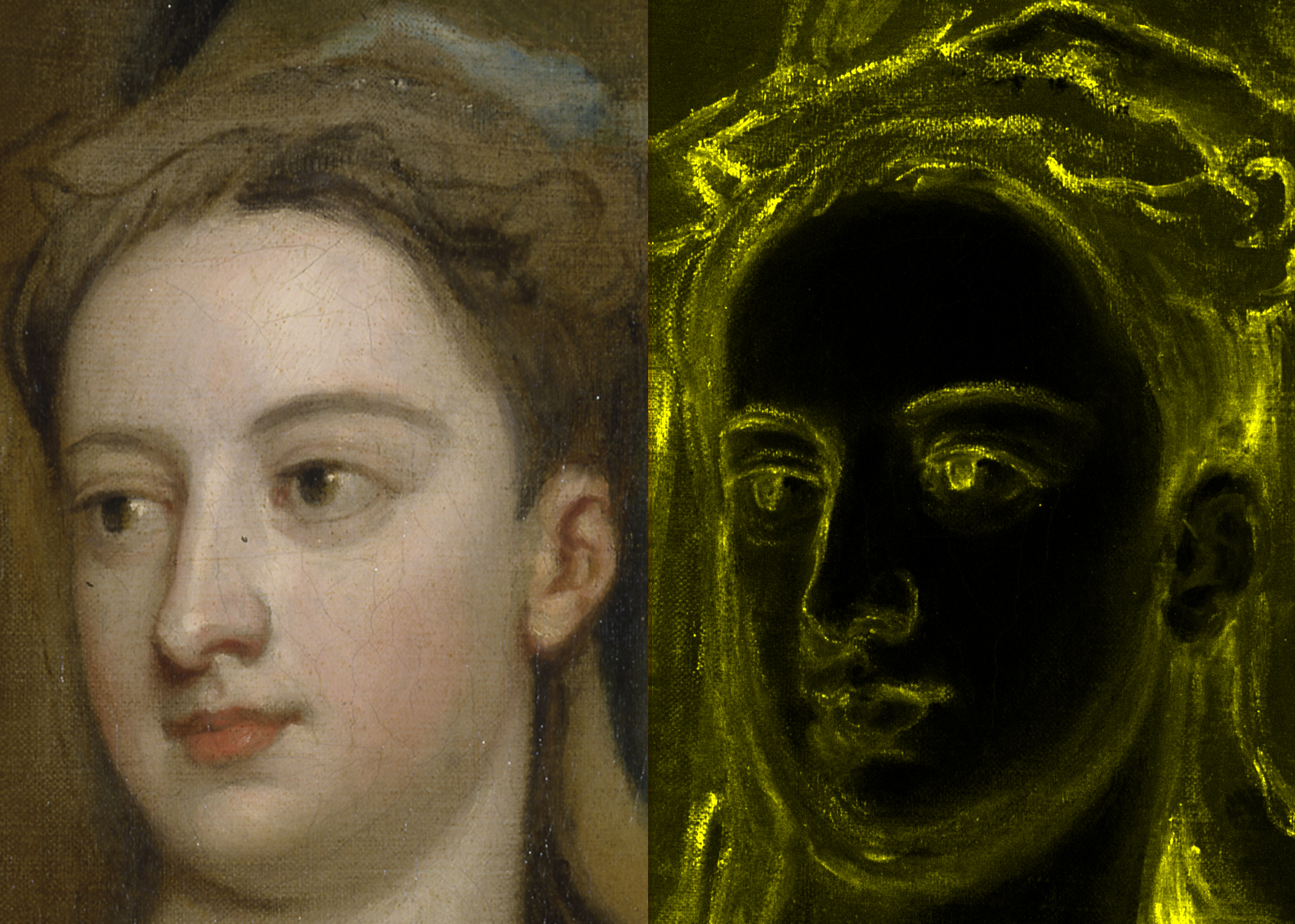 Fig. 19
Fig. 19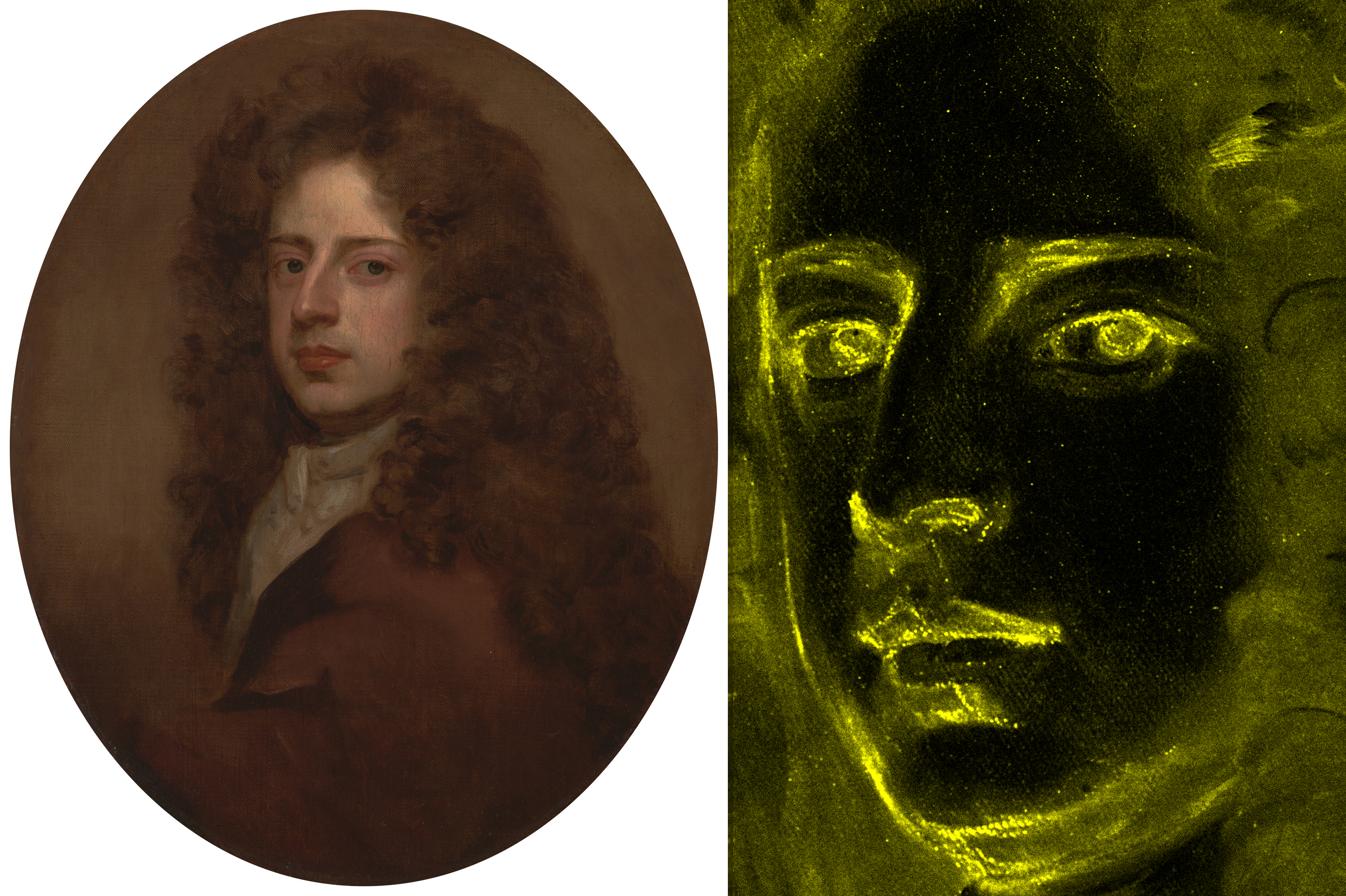 Fig. 20
Fig. 20Ostensible evidence of under-drawing material is less frequently observed in seventeenth-century portraits than in those from the previous century. However, this does not indicate its absence, but rather the limitations of traditional analytical techniques, like infrared imaging and microscopy in identifying the under-drawing material. Both Lady Mary and Kneller’s Self-portrait contain distinct lines of calcium corresponding to the contours of the face and (Mary’s) hands (Figs. 19, 20).59 Those broken, skittering lines give the impression of a dry drawing material dragged over the canvas weave, which only survived imbibement into the oil paint layer because the paint did not cover it. Linear strokes containing the same density of calcium are present on Kneller’s Lucretia of 1672–75 and Portrait of a Woman as St. Agnes, Traditionally Identified as Catherine Voss of 1705–10 (both YCBA), but those lines are a bit softer, as if smudged or applied as a wet medium. The apparent variety (and sometimes combination) of Kneller’s preparatory marks—a chalk used to draw or transfer facial features, a fluid brown paint to approximate the sitter’s postures and place shadow lines on the face and hands, and occasionally a light flesh hue (in paint) to sketch the contours of hair or wig with a squiggle—supports his reputation as a deft, instinctive maker.
Kneller’s statement to Pope that he could not place Lady Mary’s head on a prefabricated pose, his words to Gandy on capturing likeness and spirit, and the unfinished portraits left in his studio with only the faces articulated (as opposed to their figures), demonstrate fundamental ways in which his practice differed from Lely’s. And yet, much like his predecessor as Principal Painter to the King, the scale of Kneller’s studio and hundreds of unfinished portraits potentially completed by others upon his death, pose a challenge to the concept of a clear and concisely defined “oeuvre, or what makes a signature example when one name can be associated with such variety. 60 These circumstances also present an opportunity for technical investigation to fill in (if not resolve) aspects of studio life that are only sketched by historical accounts.
Next steps and conclusion
A recent MA-XRF analysis campaign of paintings at the Yale Center for British Art has offered new insight into the painting practices of leading artists from the Tudor and Stuart periods; evidence that, when compared with historical accounts on painting and existing technical studies on comparable works, forms a clearer picture of each painter’s distinctive approach, the extent of the involvement of studio assistants, and the ways in which craft knowledge was shared and reiterated among them. Thus far, MA-XRF scanning has been conducted on fifty portraits from the Tudor and Stuart periods at the YCBA, and our conclusions are supplemented by studies made on key works in other collections, typically using other forms of analysis.61 Included are portraits by Marcus Gheeraerts the Younger, George Gower, John de Critz, Robert Peake the Elder, Peter Paul Rubens, Paul van Somer, William Larkin, Cornelius Johnson, Anthony van Dyck, Gerard Soest, Isaac Fuller, William Dobson, John Michael Wright, Peter Lely, Mary Beale, John Greenhill, Simon Verelst, Godfrey Kneller, John Riley, and William Wissing. This approximately eighty-year range of portraits encompasses broad stylistic shifts that do not necessarily require technical analysis to appreciate. Our objective in including several generations of painters in this study is to extend beyond individual object or artist-based case studies toward a technical survey that supports both focused queries and broader appraisal of developments in portraiture over a hundred years of British painting.
The continued progress of this project is dependent on partnerships with other collections and research teams willing to collate their technical data with ours. Thus far, only a portion of the YCBA’s Tudor and Stuart portraits have undergone a full suite of analysis including MA-XRF scanning. As the investigation continues and more is revealed of those objects and their makers, the need for additional comparative material becomes more pressing—for example, where a specific artist or an exemplary artwork is unrepresented or underrepresented in the YCBA’s collection. Other considerations that were touched lightly upon here, including authorship, quality, condition, and accessibility, levy additional challenges in interpreting a data set like this, which is why, at least at this stage, we favor the largest possible net to gather a breadth of evidence that can be interpreted from various perspectives. With these new insights comes the possibility of a renewed phase of art historical interest and inquiry into the materials and techniques of these and other painters of the period, centering their practice as the principal means by which to interpret their work. For so long, there has been an overreliance upon contemporary anecdote and what else might survive in the paper archive. This new approach not only fills some substantial gaps in our knowledge, but also helps distinguish the difference between what was said and what was actually done.
Authors’ Bios
Jessica David is the Senior Paintings Conservator at the Yale Center for British Art, New Haven. She received her Post-graduate Diploma in the Conservation of Easel Paintings from The Hamilton Kerr Institute and was subsequently a Kress Conservation Fellow at The Frans Hals Museum in The Netherlands before joining the YCBA in 2008. Her recent research has focused on the artistic practices, materials and influence of immigrant painters in Britain. She is currently a principal investigator on the ‘Reformation to Restoration’ project, developing a technical catalog and exhibition of the Center’s Tudor and early Stuart portraits. Address: Yale Center for British Art, 1080 Chapel Street, P.O. Box 208280, New Haven, CT 06520-8280, USA. Email: jessica.david@yale.edu.
Richard Hark is a conservation scientist at the Institute for the Preservation of Cultural Heritage at Yale University. He previously was a chemistry professor at Juniata College and Marietta College. Richard received his PhD in Organic Chemistry from the University of Pennsylvania in 1993. Address: Yale Institute for the Preservation of Cultural Heritage, PO Box 27395, West Haven, CT 06516-7395, USA. Email: richard.hark@yale.edu.
Edward Town is Head of Collections Information and Access at the Yale Center for British Art. His research focuses on biography and the production of art in the early modern period, particularly that of Britain. He was a co-author and contributor to Painting in Britain 1500-1630 (British Academy, 2015) and Marking Time: Objects, People, and Their Lives, 1500-1800 (Yale University Press, 2020) and has published numerous articles on artistic production in the sixteenth and seventeenth centuries including: ‘A Biographical Dictionary of London Painters 1547-1625’ (Walpole Society, 2014) and (with Jessica David) ‘George Gower: portraitist, Mercer, Serjeant-Painter’ (The Burlington Magazine, September 2020). Address: as for David. Email: edward.town@yale.edu.
Notes
The titular quotation derives from the “Commonplace Book” of Dr. Thomas Marshall, MS Marshall 80 (dated 1640s), Bodleian Library, Oxford, quoted in Mansfield Kirby Talley, Portrait Painting in England: Studies in the Technical Literature before 1700 (Paul Mellon Centre, 1981), 150—a foundational text that has hugely influenced the research presented here. The full quote is as follows: “Most art lovers are so little aware of what the work of art they see really consists of, that they find it difficult to point out a real master among hundreds, who can explain understandably in which way and in what manner the artist has accomplished what he set out to do.” This is possibly the only English translation from a portion of Dutch script in Marshall’s writing that deals with the painting practice of Sir Anthony van Dyck. The text is also referenced in Adam Samuel Eaker, “Lore of the Studio: Van Dyck, Rubens, and the Status of Portraiture” (PhD diss., Columbia University, 2016), [https://doi.org/10.7916/D8SJ1KKQ]{.ul}. ↩︎
A number of portrait miniatures by painters like David des Granges, Nicholas Hilliard, John Hoskins, Edward Norgate, and Isaac Oliver were included in the study and are certainly relevant in terms of the comparison of historical accounts on “limning” to extant works but are omitted from this focused discussion on oil-painting practice. ↩︎
The interpretation of XRF data and its relationship to historical accounts of painting are underpinned by close looking, microscopy, infrared imaging, X-radiography, and paint cross-section analysis. The following instrumentation was utilized, although not all techniques are illustrated here: Olympus SZX16 stereo microscope for examination of paint layers, used with an Olympus DP73 microscope digital camera; Olympus BX51 stereo microscope for study of cross-sections and paint dispersions used with an Olympus DP72 microscope digital camera; Nikon D700 with a Micro-Nikkor 105-mm lens for macro photography; retrofitted Nikon D810 camera with a Coastal Optical 60-mm, macro 1:4, apochromatic lens that captures in the near IR range; Goodrich InGaAs SWIR (GA1280J) with a 0.9–1.7 μm range, used with an Edmund Optics 50mm SWIR Series Fixed Focal Length Lens; X-radiography with a Comet CXR-105 100 kV Unipolar-Open beam tube with a GE CRx Vision Scanner and GE Rhythm RT/Review Software. ↩︎
Anikó Bezur et al., Handheld XRF in Cultural Heritage: A Practical Workbook for Conservators (Los Angeles: Getty Conservation Institute, 2020): 152–54. ↩︎
Matthias Alfeld et al., “Optimization of Mobile Scanning Macro-XRF Systems for the in situ Investigation of Historical Paintings,” Journal of Analytical Atomic Spectrometry 26, no. 5 (2011): 899–909. ↩︎
More on the MA-XRF scanning of the Night Watch (1642), Rijksmuseum, Amsterdam, can be found at “Operation Night Watch,” accessed 14 May 2021, [https://www.rijksmuseum.nl/en/whats-on/exhibitions/operation-night-watch]{.ul}. ↩︎
MA-XRF maps were collected using a Bruker M6 Jetstream. The instrument was equipped with a Rh target and operated at 50 kV and 300 μA. The entire painting was imaged using a 400-μm X-ray spot size, pixel size of 350 μm and a dwell time of 10 ms per pixel. Close-up scans of eye and cheek passages were obtained using a 100-μm spot size, pixel size of 50 μm and a dwell time of 75 ms/pixel. Each face was also scanned using a 200-μm spot size, 150-μm pixel size and 20-ms/pixel dwell time. Except for scans of entire paintings, a He purge of 0.6 L/min was utilized to enhance detection of lighter elements. Element maps were generated after the data was processed using either the Bruker M6 software or Pymca and Datamuncher. A specific color was assigned to each element by the authors for consistency and increased visibility when the maps are overlaid. ↩︎
To provide directly comparable images, consistent gamma levels were maintained across the MA-XRF eye scans illustrated in fig. 1. It should be noted that examples a and b also contain lower levels of copper across the entire flesh area; however, because there is so much more on the surface of the paint layer, the surrounding, weaker signals for copper are suppressed in the images. In other words, the very high levels of copper in certain areas obscure the low levels of copper in all other areas. On the other examples (c–i), copper levels are consistently lower. ↩︎
In addition to the projects described above, numerous significant contributions have been made to the understanding of seventeenth- and eighteenth-century painting practice, and specifically the accuracy of historical written accounts in consideration of new technical analysis of contemporary artworks, among them, Mansfield Kirby Talley and Karin Groen, “Thomas Bardwell and His Practice of Painting: A Comparative Investigation between Described and Actual Painting Technique,” Studies in Conservation 20, no. 2 (1975): 44–108; Ella Hendriks and Karin Groen, “Lely’s Studio Practice,” Hamilton Kerr Institute Bulletin 2 (1994): 21–37; Sylvana Barrett and Dusan C. Stulik, “An Integrated Approach for the Study of Painting Techniques,” Historical Painting Techniques, Materials, and Studio Practice: Preprints of a Symposium, University of Leiden, the Netherlands, 26–29 June 1995, ed. Arie Wallert, Erma Hermens, and Marja F. J. Peck (Marina del Rey, CA: Getty Conservation Institute, 1996), 6–11; M. J. N. Stols-Witlox, Historical Recipes for Preparatory Layers for Oil Paintings in Manuals, Manuscripts, and Handbooks in North West Europe, 1550–1900: Analysis and Reconstructions (PhD diss., University of Amsterdam), accessed February 15, 2021, [https://hdl.handle.net/11245/1.430263]{.ul}; Alison Stock, “Does the de Mayerne Manuscript Reflect Contemporary Studio Practice?,” in In Artists’ Footsteps: The Reconstruction of Pigments and Paintings; Studies in Honour of Renate Woudhuysen-Keller (n.p.: Antique Collectors’ Club, 2013), 109–115. ↩︎
“Vertue’s Note Book A.c. (British Museum Add. MS 23,075),” Volume of the Walpole Society 20 (1931–32): 120. ↩︎
Both Lely and Kneller received a knighthood, Lely in the year before his death (1679) and Kneller in 1691. ↩︎
See Talley, Portrait Painting in England, 171–90. ↩︎
Nicholas Hilliard’s Treatise Concerning the Art of Limning ((1598–1602/3) is a notable exception, published by the painter about his craft at the height of his career. Authors such as Richard Blome, Daniel King, William Sanderson, and Marshall Smith fall into the other, larger category of artists of modest reputation, gentleman of low rank, or unknowns: Richard Blome, The Gentleman’s Recreation in Two Parts: the first being an encyclopedy of the arts and sciences . . . (London, 1686), accessed February 12, 2021, Early English Books Online Text Creation Partnership, [https://quod.lib.umich.edu/e/eebo/A28396.0001.001]{.ul}; Daniel King, Miniature, or the Art of Limning, the Maner and use of the Colours Both for Picture by the Life, Landskip, History; Dedicated to Mary, Daughter of Thomas Lord Fairfax (British Library, Add MS 12461); William Sanderson, Graphice. The use of the pen and pencil . Or, the most excellent art of painting (London: Robert Crofts, 1658); Marshall Smith, The Art of Painting According to the Theory and Practise of the Best Italian, French, and Germane Masters . . . (London, 1692). ↩︎
There are numerous historical accounts of drapery and landscape painters either working in the studios of portrait painters or being sent their canvases to complete specific passages. Jean André Roquet provides a glimpse of drapery painter Joseph van Aken’s enterprise: “he used to have canvasses sent him from different parts of London, and by the stage coaches from the most remote towns in England, on which one or more masks [faces] were painted, and at the bottom of which the painter who sent them took care to add the description of the figures, whether large or small.” Roquet, The Present State of the Arts in England, trans. J. Nourse (1755; London: Cornmarket Press, 1970), 45. ↩︎
The task of completing and restoring these paintings fell both to assistants working in Lely’s studio at the end of his life, like Henrik Sonnius, as well as to more established painters including William Wissing, Gaspar or Caspar “Magdalen” Smith, Peter Nason, and Pieter Gerritsz van Roestraten. See Mansfield Kirby Talley, “Executors Account-Book of Sir Peter Lely, 1679–1691,” in Portrait Painting in England, 360; Talley, “Extracts from the Executors Account-Book of Sir Peter Lely, 1679–1691: An Account of the Contents of Sir Peter’s Studio,” Burlington Magazine 120, no. 908 (1978): 745–49; and the anonymous, unpublished Book of Accompts of the Hon. Roger North, Dr. William Stokeham, and Hugh May, executors of Sir Peter Lely, during the years 1679–1692, British Library, Add MS 16174, 12v–16r. ↩︎
For more on the pricing of portraiture, the role of studio assistants, and copy making during this period, see also “Van Dyck’s London Studio,” in Van Dyck and Britain, ed. Karen Hearn (London:, Tate Britain, 2009), 152–69; Linda Bauer, “Van Dyck, Replicas and Tracing,” Burlington Magazine 149, no. 1427 (2007): 99–101; J. D. Stewart, “Records of Payment to Sir Godfrey Kneller and His Contemporaries,” Burlington Magazine 113, no. 814 (1971): 30–33. ↩︎
See Karen Hearn, Cornelius Johnson (London: Paul Holberton, 2015); and Edward Town and Jessica David, “The Early Career of Cornelius Johnson, 1593–1627,” in Cornelius Johnson: Painter to King and Country (London: Weiss Gallery, 2016), 18–-35. ↩︎
Regarding orpiment, see Donald Fels, Lost Secrets of Flemish Painting: Including the First Complete English Translation of the De Mayerne Manuscript, B. M. Sloane 2052 (Hillside, VA: Alchemist), 118; and J. A. van de Graaf, “Het De Mayerne Manuscript als Bron voor de Schildertechniek van de Barok” (PhD diss., University of Utrecht, 1958, 174). See also Hearn, Cornelius Johnson, 63. Various scholars have noted that this section of the manuscript appears to be written in a different hand; Hearn suggests it could be Johnson’s. See also King, Miniature, or the Art of Limning, f. 46v. For more on the compilation and content of King’s manuscript, see Talley, Portrait Painting in England, 207–27. ↩︎
The anonymous author of The Excellency of the Pen and Pencil (London, 1668) wrote that “sweeting” will “drive and intermix the Colours one into another, that they will appear as if they were all laid on once, and not at several times” (102). King, among other authors, uses the term “sweeten” to describe soft blending (Miniature, or the Art of Limning, 47r). On sweetening brushes see also R. D. Harley, “Artists’ Brushes: Historical Evidence from the Sixteenth to the Nineteenth Century,” Studies in Conservation 17, supp. 1 (1972): 123–29**.** ↩︎
Rica Jones and Joyce H. Townsend, “Portrait of Susanna Temple, later Lady Lister, 1620 by Cornelius Johnson,” Tudor and Stuart Technical Entries, accessed Februray 2021, [https://www.tate.org.uk/about-us/projects/tudor-stuart-technical-research/entries/portrait-susanna-temple-later-lady-lister]{.ul}. ↩︎
Another version of Johnson’s Sir Alexander Temple is at Hagley Hall, Stourbridge. On Johnson’s copy making and pricing, see Hearn, Cornelius Johnson, 18–19. ↩︎
Hearn notes these and additional characteristics of Johnson’s portraiture in Cornelius Johnson, 8–9. ↩︎
The term bice here refers to a blue pigment, often a low-grade, fine copper blue related to azurite, but elsewhere it may also refer to a synthetic basic copper carbonate (synthetic azurite). Talley compiled a list of pigments mentioned in notable historical texts on portraiture in Portrait Painting in England, 400–405. See also R. D. Harley, Artists’ Pigments c. 1600–1835: A Study in English Documentary Sources, 2nd ed. (London: Butterworth Scientific, 1982), and for bice see p. 47. ↩︎
For more on the historical production of lake pigments and their recipes, see Jo Kirby, Marika Spring, and Catherine Higgitt, “The Technology of Red Lake Pigment Manufacture: Study of the Dyestuff Substrate,” National Gallery Technical Bulletin 26 (2005): 71–87; and Jo Kirby, Maarten van Bommel, and André Verhecken, Natural Colorants for Dyeing and Lake Pigments: Practical Recipes and their Historical Sources (London: Archetype), 2014. ↩︎
Johnson produced several (known), small-scale versions or adaptations of Van Dyck portraits, including an oil on copper of Charles II as Prince of Wales with a Spaniel now in the collection of Crab Tree Farm, Lake Bluff, Illinois. For more on Van Dyck’s influence in Britain and his London studio, see Hearn, Van Dyck and Britain, 10–13; and Hearn, Cornelius Johnson, 24–26, 30–33. ↩︎
King, Miniature, or the Art of Limning, f. 42r. ↩︎
Talley (Portrait Painting in England, 208) notes that when pigments are listed in manuscripts without punctuation this generally implies a mixture of those named colors. ↩︎
The identification of copper using XRF is fairly straightforward, but interpreting it as azurite blue, rather than a green or a paint additive (such as a drying agent) requires additional consideration and/ or analysis. Henry Peacham, for example, urged painters to include verdigris (the copper-based green pigment) when modeling black textiles and hair: “For blacke-velvet, take Lampe-black and Verdigeace for your first ground; but then when its dry, lay it over with Ivory blacke and Verdigreace, (to helpe it to dry).” Peacham, The Compleat Gentleman (London, 1622; repr. Oxford: Claredon: 1906), 132. De Mayerne notes the use of siccatives, specifically for slow-drying lake and (an unidentified) black, referencing copper-containing “verdet” [verdigris], white copperas, and umber. See Graaf, De Mayerne Manuscript, 187. See also Marika Spring, “New Insights into the Materials of Fifteenth- and Sixteenth-Century Netherlandish Paintings in the National Gallery, London,” Heritage Science 5, no. 40 (2017), [https://doi.org/10.1186/s40494-017-0152-3]{.ul}; and on other siccatives, Marika Spring, “Colourless Powdered Glass as an Additive in Fifteenth- and Sixteenth-Century European Paintings,” National Gallery Technical Bulletin 33 (2012), 4–26. For more on Van Dyck’s palette, flesh painting, and use of azurite, see Ashok Roy, “The National Gallery Van Dycks: Technique and Development, National Gallery Technical Bulletin 20 (1999): 50–83. ↩︎
A copy of the “Gandy manuscript” was transcribed into what is now called the “Memorandum Book, 1777–1795,” compiled with the Memorandum Books of Ozias Humphry, R.A., containing notes of travel, observations on paintings, diaries of his own occupations, and miscellaneous entries . . . , British Library, Add MS 22950. ↩︎
Gandy, Add MS 22950, f. 39v (pp. numbered 23). The pages related to “Gandy’s” notes are numbered differently from the rest of the book. Each set of facing pages in this section was given a single number. For clarity, both the folio numbers and the written page numbers are recorded here. On the use of the term “to break” (paint hues and values) in historical English-language texts, see Ulrike Kern, “The Origins of Broken Colours,” Journal of the Warburg and Courtauld Institutes 79 (2016): 187–89. ↩︎
Gandy, Add MS 22950, f. 38r (pp. 21). Gandy does not identify Van Dyck’s blue as azurite. ↩︎
Gandy, Add MS 22950, f. 32v (pp. 16). On the possible identity of Mr. Fever, see Talley, Portrait Painting in England, 315–20. ↩︎
Fever told Gandy that Lely mixed up to forty flesh tints on his palette, “tempered” to match the subjects’ flesh as observed from life. This may explain why Lely took such a great deal of time to complete just his sitters’ heads. Gandy, Add MS 22950, f. 20v (pp. 4). ↩︎
Gandy, Add MS 22950, f. 24v (pp. 8). “Hack” seems to refer to merging adjacent paint passages discreetly rather than blending them together or “sweetening” them. ↩︎
“Vertue’s Note Book A.q. [British Museum, Add. MS. 23,071],” Volume of the Walpole Society 24 (1935–36): 28. For more on Lely’s mentoring, see Diana Dethloff, “Lely, Drawing, and the Training of Artists,” in Court, Country, City: British Art and Architecture, 1660–1735, ed. Mark Hallett, Nigel Llewellyn, and Martin Myrone (New Haven: Yale Center for British Art; London: Paul Mellon Centre for Studies in British Art, 2016), 291–312. ↩︎
The Beales commissioned portraits from Lely of several friends so that they could observe him at work. Lely accepted a portion of his fee in the form of pigment, including ultramarine and lake. According to Charles, Mary took copious notes during these sessions, but after several visits both husband and wife noted that Lely became guarded and worked in a “more conceiled mysterious scanty way of painting then the way he used formerly, wch wee both thought was a farr more open & free & much more was to be observed and gained from.” “Vertue’s Note Book A.q.,” 170. ↩︎
An unfinished portrait of James II by Lely (National Portrait Gallery, London, inv. 5211), including just the sitter’s head, showcases his subtly laid patches of unblended flesh tints. Such a study could be the source of multiple versions, incorporated onto “poses” by studio assistants. ↩︎
See Talley, Portrait Painting in England, 335. ↩︎
Gandy, Add MS 22950, f. 21r (pp. 4). ↩︎
Consistent with examples discussed above, Lely adjusted his palette according to the gender of his sitter. Gandy’s friend Fever reported watching Lely work up a portrait of the 2nd Earl of Sandwich and questioned Lely as to why the Earl’s complexion was so bright and red in places. Lely assured Fever and the Earl that the colors would lose their strength in the drying process. Fever noted of Lely’s palette for female sitters that “Mr. Lilly uses Ultramarine very seldom about a very fair Lady’s face, for his Men removes it.” Gandy, Add MS 22950, f. 25v (pp. 9); f. 21r (pp. 4). ↩︎
Gandy, Add MS 22950, f. 35v–36v (pp. 19–20). ↩︎
Gandy, Add MS 22950, f. 32r, 32v (pp. 15–16). ↩︎
See note 36. For more on Charles Beale’s pigments and their exchange, see Talley, Portrait Painting in England, 276–77. ↩︎
Out of thirty documented notebooks kept by Charles Beale, only two survive (1676/7) and (1680/1) at the Bodleian Library, Oxford University, and the National Portrait Gallery Archive, respectively. Much of what exists was reiterated, in some form, by Vertue in his notebooks. See also Talley, Portrait Painting in England, 270–305. ↩︎
Charles lists numerous copies made by Mary, some after privately owned paintings that were borrowed for the express purpose of reproduction; her son, Charles Jr., was sometimes sent to fetch and return them. For example, in July 1681 Charles recorded that “my D. heart finisht the first Coppy of ye HL. [the honorable lady] of Lady Ogles picture after Sr. P [Sir Peter] Lely at Newcastle House. “Vertue’s Note Book A.x. [British Museum, Add. MS. 23,072],” Volume of the Walpole Society 24 (1935–36): 175. ↩︎
“Vertue’s Note Book A.x.,” 168–69. ↩︎
For commissioned portraits and copies, Mary could take up to four sittings for the likeness and flesh painting, plus several additional days to finish the sitter’s clothing and the background. See Talley, Portrait Painting in England, 294–97. ↩︎
For discussion on a comparable Beale at the Tate, see Rica Jones and Joyce H. Townsend, “Portrait of a Young Girl, c. 1681 by Mary Beale,” Tudor and Stuart Technical Research Entries, accessed February 2021, [https://www.tate.org.uk/about-us/projects/tudor-stuart-technical-research/entries/portrait-young-girl-c1681]{.ul}. ↩︎
The presence of a brown oil “sketch” between the ground and upper paint layers is ubiquitous among the portraits discussed here. The hue is typically a warm brown, composed of brown umber, earths, and/or a red lake, applied with a fine brush to delineate facial features (possibly over a charcoal or chalk sketch). A broader brush was sometimes used to block in the background and add approximate values to the sitters’ heads and costumes. ↩︎
As noted above regarding the portrait of Martha Temple, Lady Penyston, XRF analysis is incapable of identifying organic materials such as the colorant of lake pigments, but the presence of substrate materials (calcium carbonate, potassium carbonate) can offer clues to the locations of now-faded lakes. For instance, MA-XRF shows crisp strokes of a calcium-containing material on Bart’s upper lip, nostrils, irises, and upper lash lines. Those calcium-rich marks do not correspond to other materials identified with XRF (like earth, umber, vermilion, or bone black pigment), implying it was added discreetly. Its pattern is consistent with a method of underpainting described by the anonymous author of The Excellency of the Pen and Pencil: “tracing out these parts with Lake is to be done before you lay on any Colour” (101). The author then suggests wiping the color away lightly so it doesn’t “overcome” the other colors. ↩︎
Roquet, Present State of the Arts in England, 34. ↩︎
On Kneller’s studio and his placement of mirrors, see Gandy, Add MS 22950, f. 32r. When Alexander Pope wrote to Lady Wortley of Kneller’s consent to visit her, he impressed upon her that it was “a manner in which they seldom draw any but Crown’d Heads” (i.e., members of the royal household). Pope, The Correspondence of Alexander Pope, vol. 2, 1720, ed. George Sherburn (Oxford: Clarendon, 1956), 22. ↩︎
Pope, Correspondence, 22. ↩︎
Except for impasto passages, the body of Kneller’s paint appears lean and quite liquid. This may have been intentional, to encourage the paint’s fluidity in support of his fast brushwork. Fever noted that Kneller had a habit of cleaning his brushes in linseed oil and proceeding to use them without wiping the residue, making the oil “swim” on the color and, according to Fever, to “starve them” (perhaps as the paint became diluted and sullied by pigment residue from the oil pot). Gandy, Add MS 22950, f. 33v. William T. Whitley references a number of passages (like the above) from the Gandy manuscript, which he encountered via Ozias Humphry’s “notebooks” before Gandy was identified as their source. Whitley, Artists and Their Friends in England, 1700–1799 (London: Medici Society, 1928), 237. ↩︎
Gandy, Add MS 22950, f. 45v–46r (pp. 29). ↩︎
Gandy, Add MS 22950, f. 45v. ↩︎
For comparison to technical studies on comparable Kneller portraits, specifically his application and use of under- and preparatory layers, see Rica Jones and Joyce H. Townsend, “John Smith the Engraver 1696, by Godfrey Kneller,” Tudor and Stuart Technical Entries, accessed February 2021, [https://www.tate.org.uk/about-us/projects/tudor-stuart-technical-research/entries/john-smith-engraver-1696]{.ul}; and Jones and Townsend, “The Harvey Family 1721, by Godfrey Kneller,” Tudor and Stuart Technical Entries, accessed February 2021, [https://www.tate.org.uk/about-us/projects/tudor-stuart-technical-research/entries/harvey-family-1721]{.ul}. ↩︎
For more on Kneller’s technique and analysis of his “Kit-Cat” or “Kit-Kat” portraits (depicting members of the Kit-Cat dining club), see Talley, Portrait Painting in England, 344–56; see also the unfinished portrait of Richard Boyle, 2nd Viscount of Shannon at the National Portrait Gallery, London (inv. 3235). ↩︎
There is no visible colorant within the passages that contain the calcium mentioned here. ↩︎
Like Lely, Kneller left hundreds of unfinished portraits in his studio, and his will stipulated that “no finished portraits shall be delivered under the usual price (15 guineas for a head, 20 with one hand, 30 for a half, and 60 for a whole length . . .), but that those left unfinished shall be finished by [Edward] Byng [his assistant],” quoted in C. H. Collins Baker, Lely and Stuart Portrait Painters: A Study of English Portraiture Before and after Van Dyck (London: P. L. Warner, publisher to the Medici Society, 1912), 93. See also Roquet, Present State of the Arts in England, 33. ↩︎
In situ analysis was conducted using a Bruker Tracer III-SD handheld X-ray fluorescence spectrometer in the collections of the Denver Art Museum by Roxanne Sperber (then at Yale’s Institute for the Preservation of Cultural Heritage), and at the National Portrait Gallery, London, and at National Trust UK properties by Richard Hark (author). The authors are grateful to the following for sharing their expertise and access to their collections: Matthew Hargraves, Chief Curator of Art Collections at the YCBA, Kathleen Stuart, then at the Denver Art Museum; Charlotte Bolland, Alexandra Gent, and Polly Saltmarsh, National Portrait Gallery, London; Gerry Alabone, Daniel Cull, Christine Sitwell, and David Taylor, National Trust, UK; David Solkin, Professor Emeritus, Dept. of History of Art, The Courtauld Institute of Art; Lawrence Hendra and Philip Mould, Philip Mould Gallery, London; and Florence Evans, Charles Mackay, and Mark Weiss, Weiss Gallery, London. ↩︎
| words